

Report: Collector portraits
Meeting collectors around the world: a mini-series

A powerful new voice
he passion and art of collecting is certainly as old as the Promethean attempt to measure, quantify and reverse the passing of time. Who knows if there were not clepsydra collectors in ancient times? There have always been clock enthusiasts. But they have never been as powerful as they are today. Nor have they displayed such diverse profiles.
Whether we’re talking about 100-franc or 100,000-franc watches, a true democratisation of watch collecting has taken place, thanks to the cultural and commercial fluidity of the digital age. Anyone can now own a share of the dream, claim a brand, an expertise, a certain “angle”. A vibrant community debates on Clubhouse, but also buys and sells daily on e-commerce platforms.
Anyone can now own a share of the dream, claim a brand, an expertise, a certain “angle”. A vibrant community debates on Clubhouse, but also buys and sells daily on e-commerce platforms.
Collecting is no longer reserved for the elite. People accumulate vintage Casios or F.P. Journe watches with the same pride. Carried away by their passion, some people even proclaim themselves “guardians of the temple”, to the point of strongly criticising any brand that strays from its historical path. Digital bashing, as well as the speculation that has arisen around certain grail watches with an almost mythological status, are excesses that highlight the dynamism of this new and vocal watchmaking constituency.
Brands are unsure how to approach this community of enthusiasts, who often know more than their own employees. They are customers, yes, but they also have the freedom to criticise and resell. The dialogue of the “old world”, which essentially took place between the brands and their sales representatives, was certainly more controlled. A new voice has entered the conversation. This promises debate and controversy, but above all it ensures that the industry maintains its social and cultural relevance. A very good sign, then, to discover in our latest issue.

Watch enthusiasts always find each other
eyond the venerable national horological societies and associations that have been active for centuries, in recent years we have seen more and more watch collectors’ clubs being created around the world. It’s a sign both of the vitality of the horological scene, amplified by the new social possibilities of digital technology, but also of the desire to come together physically to share a passion for what remains, even in the age of the web, a very tangible object.
Increasingly, these associations and collectors are taking initiatives, for example to launch limited editions with brands, organise meetings and expand the global watchmaking community. In the face of the pandemic, we wanted to give a voice to those who, today more than ever, are helping to maintain the passion for watchmaking around the world. How have they organised themselves this year? What special actions have they put in place? Here is a series of testimonials.
“We expanded our financial aid programs to watchmakers”
Nicholas Manousos, Horological Society of New York, USA

“Before the pandemic, our association was known for its very well attended lectures. Our last in-person lecture was March 2, 2020, with François-Paul Journe and Osama Sendi. I remember that night very clearly, as the city was already on edge with news of the coronavirus beginning to appear elsewhere around the country.”
“Our monthly lectures and horological education classes are now held online using Zoom. Moving our events completely online has worked well. We had a lecture with Grand Seiko that attracted over 400 attendees from 23 different countries. Virtual lectures have made it possible for us to expand our reach around the world.”
“We also saw the challenges that many working watchmakers were facing because of the economic situation. With that in mind, we expanded our financial aid programs. For the first time, financial aid was given directly to working watchmakers and watchmaking schools, in addition to our traditional scholarships for watchmaking students. In total, we awarded $155,000 in financial aid for 2020.”
“This crisis puts local customers in the foreground”
Thomas Campion, Lausanne Watch Club, Switzerland

“By limiting tourism, the crisis has at least had the merit of placing local customers and collectors back in centre stage. In this sense we have contributed to the development of new communities in Europe, which will soon be grouped together in the form of a network.
“These synergies will enable us to offer more visibility to the brands, and to accompany them throughout the year at local events, meeting their clients in different markets.”
“The growing number of people affected by the virus and its psychological impact should have a lasting impact on our relationships with communities and events. Thus, we will be developing new formats in Switzerland and in Europe, on a more regular rhythm, limiting the number of people attending in favour of more personal encounters.”

“Driving technical innovation for a better future for the watch industry”
Etsuro Nakajima, The Horological Institute of Japan (HIJ), Japan

“The Horological Institute of Japan (HIJ) is an academic society established in 1948 to promote investigation and research into the watch industry and its technological applications. The activities for HIJ members include attending an annual micro-mechatronics meeting, workshops in the spring and fall, and guided tours. We also publish a bulletin called “Micromechatronics” twice a year.”
“Due to the pandemic, we were advised to exercise social distancing and avoid gatherings. We decided to publish the members’ bulletin in June and December. Bi-monthly online meetings were held for the directors and steering committee members, for managing the institute and discussing how to deal with the pandemic.”
“In 2021, we are expecting to revitalise our activities by taking countermeasures for unpredictable situations. We may hold online and/or face-to-face meetings depending on the members’ preferences. We will pursue our mission to facilitate technical discussions between watch manufacturers and engineers, driving technical innovation for a better future for the watch industry, and actively work on networking with other companies and members of universities.”
“A massive digitisation initiative”
Dr. Bernhard Huber, Deutsche Gesellschaft für Chronometrie, Germany

“The board meetings and meetings of the extended board were all held as video conferences. Most of the regional and specialised conferences had to be cancelled.”
“On the proposal of the board, the General Assembly decided to launch a massive digitisation initiative and released the necessary funds for this project. At least for the first half of 2021, we continue to expect restrictions on our activities.”
“However, as a first result of our digitisation campaign, it will be possible to attend also online the meetings of our regional chapters and of our specialised interest groups.”

©Horological Society of New York
“Pragmatically, we assume that all activities will be done online”
Dr. James Nye, Antiquarian Horological Society, United Kingdom

“The pandemic has halted physical meetings, to which the response has been to move online for webinars and video conference meetings. The main initiative is to encourage our sections and groups around the UK, and internationally, to hold their meetings via Zoom or Teams.”
“Two of our London Lectures were rescheduled for 2021, but the November 2020 Lecture went ahead as a webinar with strong attendance. The recent Dingwall Beloe/ Harrison lecture arranged by the Clockmakers Company and the British Museum had some 500 attending.”
“The production of Antiquarian Horology, the quarterly journal, has not been affected, with issues continuing on schedule, and at their standard size. The editor continues to receive a large number of submissions, so the journal is in very healthy shape. The only noticeable difference is an understandable reduction in advertising from members of the horological trade.”
“We have planned for all our activities to be online. It seems more pragmatic to assume that we cannot meet physically, and then later to change to physical meetings, if these become possible. The upside of all this is that it has forced us to consider earlier how we can provide our lecture content both online and in person, when physical meetings become possible.”
“We launched two new collaborative timepieces”
Gabe Reilly, Collective, USA

“With Covid-19 outbreaks and political uncertainty in the USA, we shifted the launch dates of our new collaborative projects. We launched two collaborations this year – the J.N. Shapiro Infinity Series P.01 for Collective and the H. Moser & Cie. Pioneer Centre Seconds Rotating Bezel C.02 for Collective – both of which sold quickly, demonstrating strong demand for new products despite the challenging environment.”
“On the positive side, the shift to a purely online community has accelerated the growth of our geographic footprint beyond our core in Silicon Valley. This means no matter where our members are, they can participate fully in the community. We accelerated our investments in our website, e-commerce, email and CRM systems. And we shifted our events plans online. For instance, we worked with one brand to host a virtual brunch.”
“Going forward, we are anticipating both best and worst case scenarios. For instance, for future collaborations and events, we are planning both online-only experiences as well as hybrid in-person and online approaches. Even if things go back to a pre-pandemic normal in 2021, we will have learned how to execute online well, and to make our community accessible to more members.”

©J.N. Shapiro Infinity Series P.01 for Collective. Atom Moore
“Online voting was a big hit with our members”
Jean-Michel Piguet, Chronométrophilia, Switzerland

“Chronométrophilia’s activities have obviously been disrupted by the health crisis, all the more so as our association has a good number of people at risk because of their age. The main activities of our association being meetings, visits to companies, museums or exhibitions, we had to completely cancel the programme planned for the year 2020.”
“Our general assembly was to take place at the end of March in Biel with a visit to the new Omega museum and the Swatch museum. This was replaced by a general meeting by correspondence, with voting possible online on our website. Many members thanked us for this possibility.”
“This health crisis was an opportunity for us to reflect on how we could maintain liaison and contact with our members. To this end, we have set up a newsletter, which we will certainly maintain in the future. For 2021, we hope that the situation will improve, so that we can resume our traditional activities (visits, conferences, meetings).”
“Still many opportunities for the watch industry in China”
Daniel Sum, Shanghai Watch Gang, China

“At the beginning of the year many of us were abroad for Chinese New Year and that’s when the virus started to hit, so we were all separated from each other. During the first half of the year, no one was in the mood to gather. It seemed the wrong thing to do and also to publicise. During July I managed to return to Shanghai and it seemed everything was back to normal. We started to have gatherings again and everyone turned out as usual. Gatherings are happening every three weeks or so.”
“With regards to the Shanghai Watch Festival, it wasn’t feasible to execute this year, as it wouldn’t have been to the standard we wished. Many independent brands aren’t able to travel without quarantine, and for the big brands – despite sales increasing significantly within the domestic China market – our understanding is that budgets are constantly being cut to balance the books globally.”
“I do find it somewhat ironic that China and the Chinese in particular have always been the main market for watches, and that is highlighted more now than ever, yet brands still fail to commit fully. I am looking forward to seeing more brands taking the plunge into the Chinese market and hopefully we can help them gain access here. So for the watch industry in China I think there are many opportunities.”
“I would say digital media use has gone up – but that would be true for many other industries. Meeting people and seeing watches is very different when done virtually – and I’m not sure right now technology can replace that. Next year, at least for the first half, I do not see anything changing and I am not convinced that the borders will open, since we are now going into the winter months when the virus will spread more rapidly, especially in uncontrollable regions, which Europe very much is.”
“Even when things open, I do feel that Chinese will be tentative about travelling. One, because of the risk, and also because of the general anti-Chinese sentiment which is now present globally. I am not saying they won’t go out, but it may not be in huge numbers. China is very large so domestic travel is also an option for Chinese who want to somewhat assuage the urge to travel.”

Claude Sfeir collects only the crème de la crème
orn in Lebanon, Claude Sfeir splits his time between Beirut and Dubai, where he was sent as a young man by his taxi-driver father four decades ago – war was already raging in Beirut – to work with one of his uncles in the traditional Gold Souk.
Since those distant days, the simple little shop in Dubai’s historic souk has gone forth and multiplied and in the space of 40 years engendered 500 “clones” – a fleet of stores employing 3,000 people “in all the duty-free shops and major hotels in the Middle East, Qatar, Abu Dhabi, Syria and Lebanon”. This exceptional expansion enabled Claude Sfeir over time to satisfy his increasingly all-consuming passion for watches, to start collecting them without restraint and to become one of the most important – and most expert – collectors in the world.
Everything began in that store. There, among the jewels that were traded, customers brought in watches. "We didn’t know how to open them, we had no idea of their possible value, so we smashed them, took out the movement and bought the whole thing by weight, for the price of the gold,” he explains. “I must have destroyed some magnificent items...”

It all began with a trip to Italy
But little by little, his interest in watchmaking grew. “It actually all began with a trip to Italy to buy gold. There, I realised the fascination that watches aroused. So I bought catalogues and began to take an interest in them. Back home, I started borrowing the sales catalogues of major auction houses from acquaintances and photocopying them – I couldn’t afford the subscription, it cost about 4,000 US dollars. That was too much for me at the time. But I began to study the subject and tried to understand what this world of watchmaking was all about. And then I got involved myself. I began by buying simple things, like little Rolexes. Step by step, every year, I progressed, I understood better, I got increasingly hooked.”
“I never sell anything, I only buy. Collecting is worse than gambling. I never stop. I’ve no limits. It’s absolutely unreasonable.”
But the “learning-by-doing” method is not without surprises, or without setbacks. Many self-proclaimed experts indulge in all kinds of dishonest manoeuvres. “I realised that many of the ’experts’ I consulted sold me biased opinions, or even untruths. So I decided to become an expert myself. You know, more than 400,000 models of mechanical chronograph were produced between 1963 and 1983. That opened the door to all kinds of fakes, semi-fakes and watch tampering. There was a substantial amount of fraud that gradually increased as interest in second-hand watches grew.”
Top-category items only
Fifteen years after debuting his career as a collector – he has now been a collector for 40 years – and having become a skilled expert by virtue of studying, comparing and evaluating, Claude Sfeir decided that from then on he would buy “only quality, top-category items, and little by little I raised the standard of my collection, focusing on the big names like Patek Philippe, Rolex, and the major independent watchmakers who were coming into their own, like François-Paul Journe and Philippe Dufour, and others...”
“But I also began purchasing prototypes, watches built specifically for the Middle East, or watches with links to famous people, like the Lemania chronograph that belonged to Winston Churchill, or the Rolex Submariner that belonged to the last Shah of Iran, and even all the watches worn by the six actors who’ve played James Bond”.
-

- On 8 November 2020 Phillips, in association with Bacs & Russo, auctioned the Simplicity 00/20 from a new edition of 20 Simplicity watches yet to come, made by the grand master watchmaker of the Joux Valley, Philippe Dufour. The watch sold for $1.5 million. Behind the operation was Claude Sfeir, a longstanding and close friend of the watchmaker.
“Every time you buy something, you’re missing something else”
Collectors always remember the first watch in their collection and when they bought it, but do they know where to stop – if they ever do? Is a collection ever finished, people ask him. Isn’t collecting a kind of illness?
“Yes, certainly. It’s a chronic illness that creeps up on you. At the beginning, you don’t know which road you’re going to take. But soon, you can’t stop going down it, even if you get lost sometimes. Basically, what drives you is that every time you buy something, you’re missing something else. And I never sell anything, I only buy. Collecting is worse than gambling. I never stop. I’ve no limits. It’s absolutely unreasonable.”
“I realised that many of the ’experts’ I consulted sold me biased opinions, or even untruths. So I decided to become an expert myself.”
The new collectors
The watch collecting scene has evolved quite considerably, becoming more global, with new actors emerging. Sales networks have multiplied, become virtual. The brands themselves are getting in on the act, restoring their own watches to put them back on the market. What are we to think about this development?
“The real, top-level collectors represent a tiny handful world- wide. In general, they don’t like selling. Aside from this expert and collecting elite – and while I’m on the subject let me pay tribute to the great pioneer, Dr Helmut Crott – there are ten thousand or more collectors worldwide, but most are investors who collect according to what return they can expect to get from it. They like to sell. They come from all over the place, from the Far East, Hong Kong, China, Japan, the US...”
“They include a lot of young people in the 24 to 33 age bracket, unknowns. Inevitably, habits change. In normal times, I go to all the auctions and I prefer by far physical sales. There are rules: no talking, no bidding against museums, matters of ethics. Physical sales will return I’m sure, even if online sales cost less for everybody, for travel, accommodation, etc.... And as far as the prices are concerned, they’re holding up. They’re being confirmed. As for the brands, it’s true that they’re also investing in pre-owned. Rolex recently authorised its retailers to open vintage counters in their outlets. Patek Philippe doesn’t do pre-owned. But you can find some beautiful vintage Patek Philippes at some of the brand’s his- torical resellers. François-Paul Journe restores and resells.”

From collector to instigator
In November 2020, together with his friend of many years Philippe Dufour, Claude Sfeir announced that he was officially taking over the commercial side, sales and distribution of Philippe Dufour production, as well as the creation of 21 Simplicity 20th Anniversary watches. Within 48 hours, there was an avalanche of demand. It was as if every collector in the world wanted one.
“It has to be said that on 8 November, the first Simplicity 20th Anniversary was sold by Aurel Bacs for Phillips for the sum of CHF 1,361,000. Enough to arouse people’s interest. In the space of 48 hours, I received 10,000 requests. 4,700 emails a day. All kinds, from all over Asia and elsewhere. Lots of young people. Each one told their story, tried to convince me of the purity and profoundness of their intentions. There was all sorts, a thousand anecdotes. But in the end, there will be only one person per country. With Philippe, we attributed the first ten watches and for the remainder we’ll hold a lottery in the presence of a judicial officer. Philippe Dufour will keep N°21 for himself and his family. And we have other projects, a grand project, really high-flying, a ladies’ chiming watch combining watchmaking and jewellery. Between you and me, I have to confess I pushed him a bit...” (laughs).
Does this man, who “doesn’t sell”, ever think about his legacy and what will become of his collection?
“Ah, I’ve got my eye on a little château in Geneva or its environs that I’ll transform into a small museum for displaying and sharing my collection. And I wish to point out that admission will be free!”
“We have other projects with Philippe Dufour, a grand project, really high-flying, a ladies’ chiming watch combining watchmaking and jewellery.”

CLAUDE SFEIR AND THE SITUATION IN LEBANON
We talked with Claude Sfeir in December 2020. His country, in the throes of a deep depression, is struggling to recover from a serious economic and social crisis multiplied by the Covid pandemic and dramatically exacerbated by the gigantic explosion at the port of Beirut in August 2020. Eight months later, the wounds are still raw. Claude Sfeir recounts:
“My store is right in the middle of the Achrafieh quarter, a historic Christian quarter close to the port where the explosion occurred. A lively, bustling quarter. The store’s bulletproof glass resisted, but my son’s leg was injured and eleven people in the building died. During the 45 years of various wars, the quarter had resisted. But this has destroyed it. Within a radius of three kilometres, 7,000 buildings have been damaged. Besides the store – where I sell watches by François-Paul Journe – I have a workshop with 2,400 m2 of floor space where, under normal circumstances, 90 people work. It has been completely destroyed.”
“The State is absent and corrupt. 95 billion dollars have evaporated into thin air from the central bank, not count- ing the losses of the other banks, which add up to 73 billion. Twenty families have stolen everything. It’s complete madness. And on top of the explosion, now there’s Covid. All the money is blocked, you’re only allowed to withdraw 1,000 dollars a month – and only if you have a million on your account! Things are going to explode. In the face of this void, I’ve set up an independent chain of solidarity from Dubai. We’ve sent 50 tonnes of medical equipment, small field hospitals. We’re also helping directly with the reconstruction of 50 houses in the quarter.”

“It’s almost embarrassing, how much time I spend on watches”
t was while studying for a law degree that Jane became interested in mechanical watches. “I like the idea that they are not disposable goods like most of the things we own today,” she explains. “Imagine, I have models from the 1940s and 1950s that are in much better condition than I ever will be when I am their age!” The notion of “handing down” and the durability of an object that has traversed several eras appeals to the young woman.
“Like other collectors, I find a personality, a soul in them, even though they are objects,” she continues. “They are part of my daily environment and I give them meaning.” During the strict lockdown she observed last year in New York, a city particularly affected by the coronavirus, her collection of watches gave her a degree of comfort: “In my eyes, they mean something as strong, if not stronger, than what a photograph can evoke. During lockdown, I spent three months at home without wearing any jewellery, but I had a vintage watch on my wrist almost every day.”
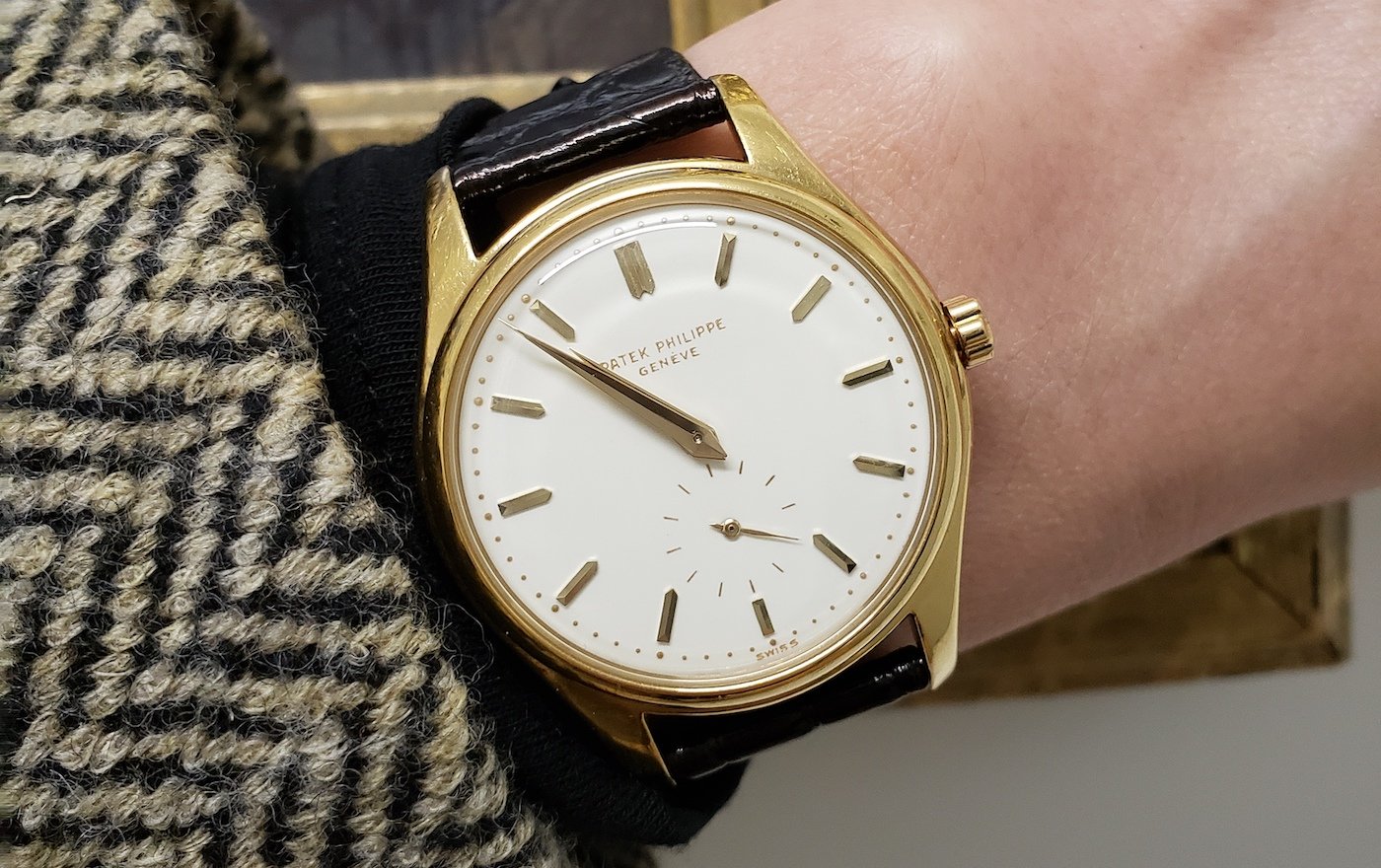
Simplicity, complexity, simplicity
Her first watch was not an entry-level model or a timepiece that was passed down to her, but a Patek Philippe Calatrava ref. 5123R-001 in rose gold that she bought herself at Betteridge Jewelers in Connecticut. “I know I’m odd in that I started with a Patek Philippe, rather than working my way up bit by bit.” From the start, Jane had a particular affection for the Geneva-based watchmaker. Her next acquisition was a ref. 7130R World Time, illustrating her predilection for chronographs and world timers. Her tastes also led her to manual rather than automatic winding calibres.
-

- Jane, a watch collector from New York
- Photo: Atom Moore
Having started her watchmaking collection with classic models featuring a simple time-only indication, and moving on to models with complications, Jane now finds herself returning to the purity of her early choices. “I went from simple to complex to simple again. It’s a process...”
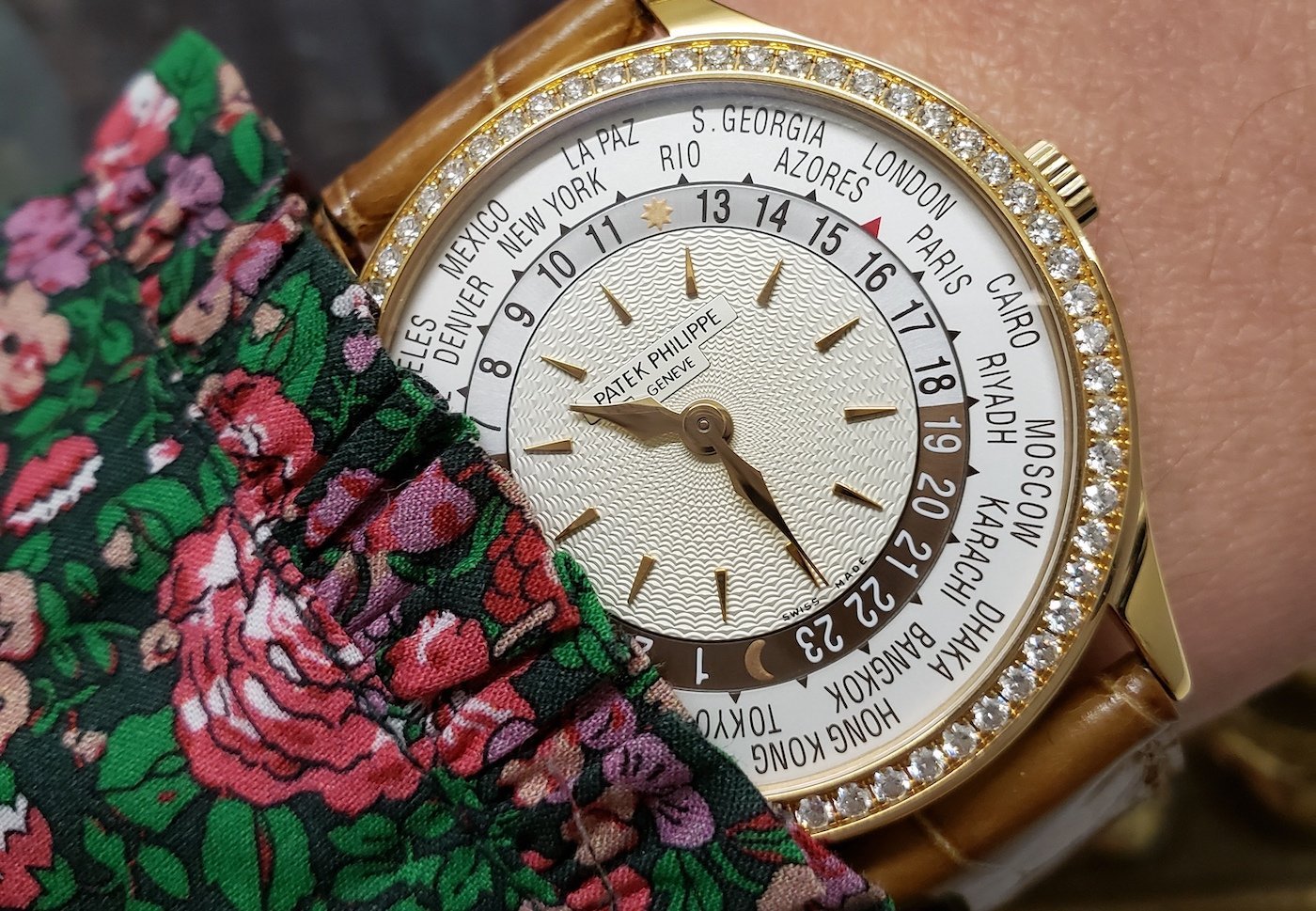
The “social” watch
The collector quickly discovered the social side of her hobby, the need to share with other collectors, and the feeling of belonging to a community in which the passion is shared but tastes differ. For several years, she has belonged to a club of watch enthusiasts named The Watch Club Society (@watchclubsociety). “Next to my work colleagues, these are the people I feel closest to in the city,” she says. She is also a member of the Horological Society of New York.
“Most of the members of my club have a broad scope and collect a lot of different types of watches. Thus they have a breadth of knowledge I don’t have. I tend to focus on a narrow field and pursue it as best I can. There are really only five or six watch brands that I follow. But I pursue them intensely and diligently.”
“I tend to focus on a narrow field and pursue it as best I can. There are really only five or six watch brands that I follow. But I pursue them intensely and diligently.”
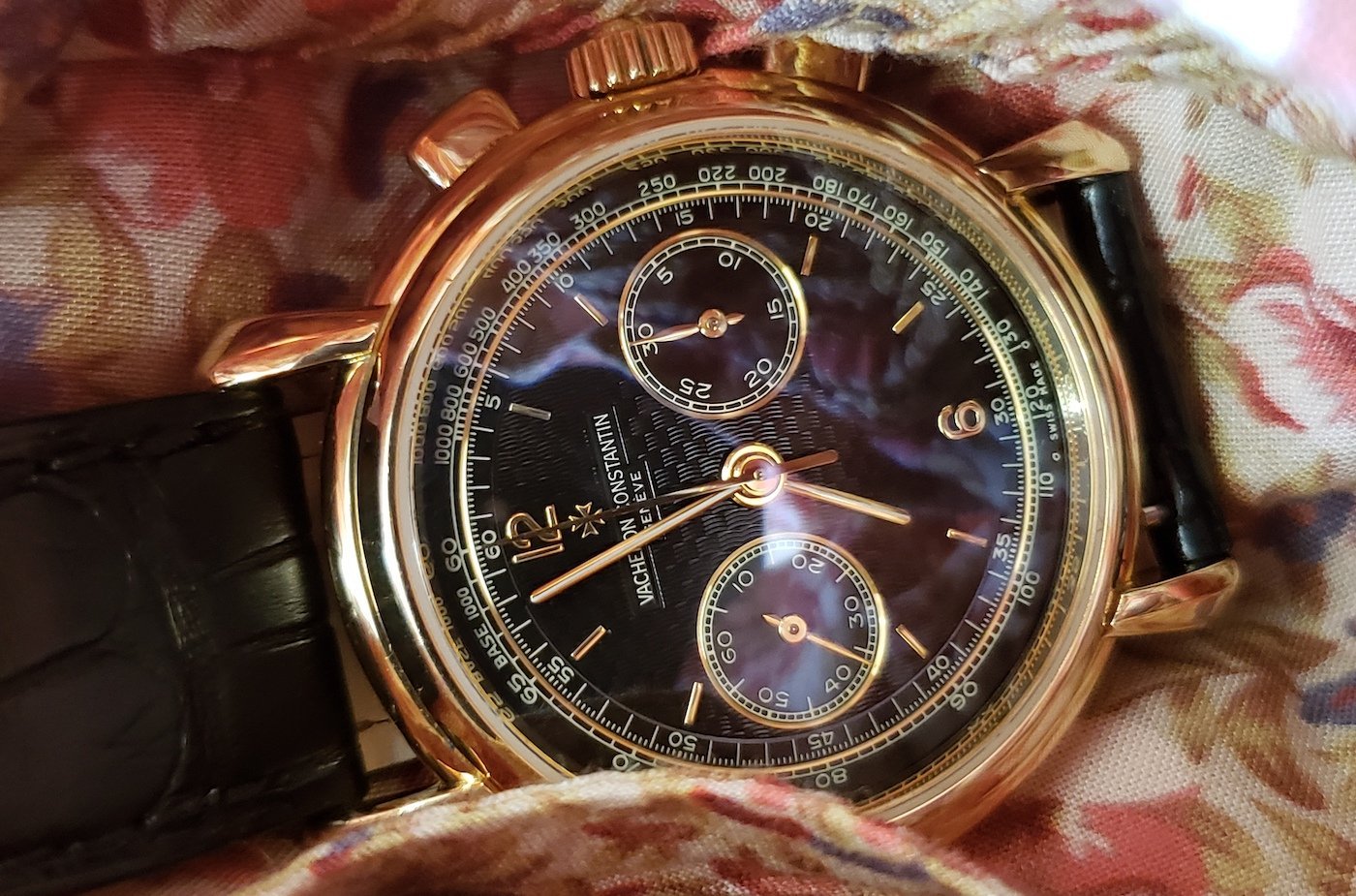
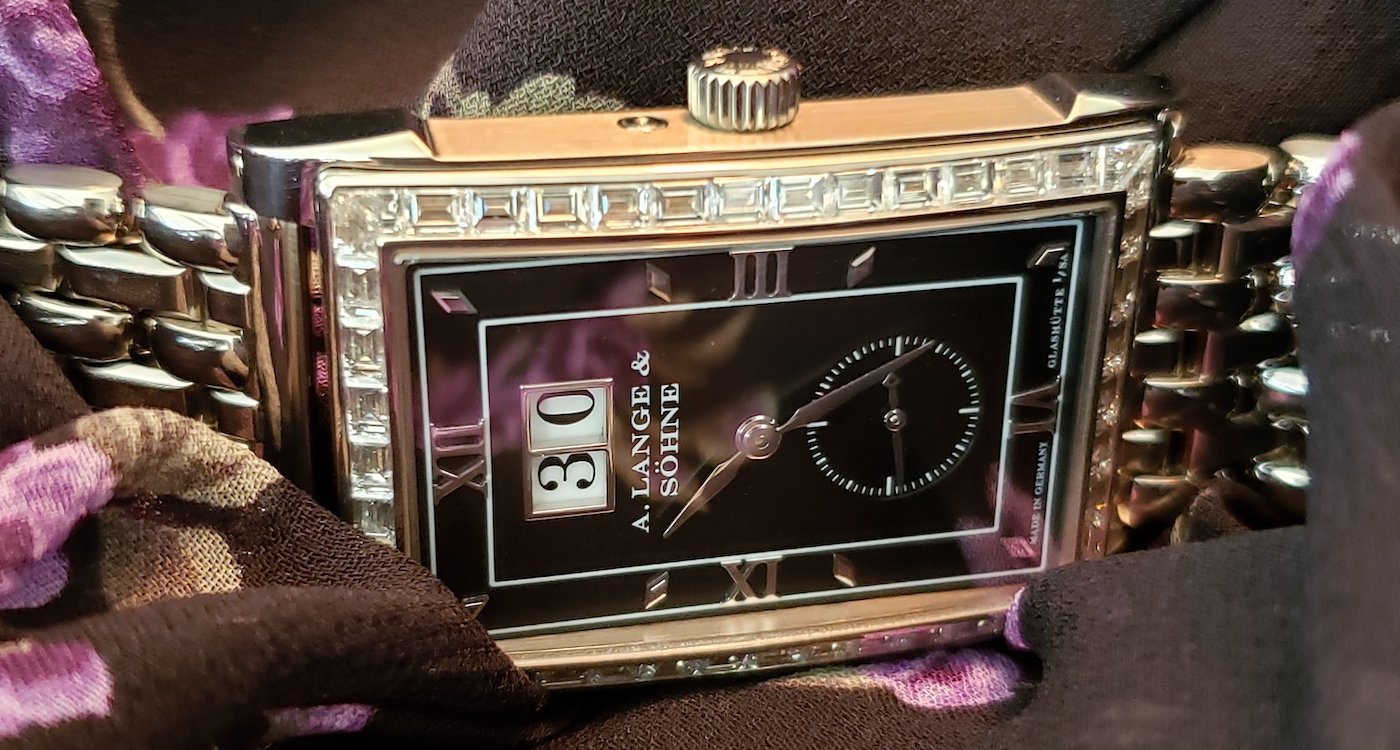
“I should hate this model... and yet!”
At the top of her personal watch pyramid sits Patek Philippe, obviously, ahead of Rolex (following her acquisition of an Oysterquartz 19018 with walnut wood burl dial from 1984), Vacheron Constantin (including a Chronograph ref. 47101 that belongs to a friend), A. Lange & Söhne (the Cabaret and others) and Cartier, a brand she refused to follow until one day in December two years ago, when she came across an unpolished Tank à Guichet from 1997... “From then on, it was a dangerous path!” Her absolute grail watch remains her Patek Philippe Calatrava ref. 2526J.
In addition to these classics, Jane has more recently become interested in the independent watchmaking scene, including the Austrian brand Habring2. She also acquired a SUB 300 carbon model by Swiss brand Doxa, which has just made a comeback in the US.
About this model she says: “This shocked some of my collector friends because they didn’t expect me to get involved in divers’ watches at all, a segment I wasn’t particularly interested in. In fact, I don’t know why I like this model. Logically, I should hate it... and yet!” Similarly, although she has little interest in pilots’ watches, she had her head turned by a Breitling Navitimer ref. 806, demonstrating that the collector’s field of action is not that limited after all!
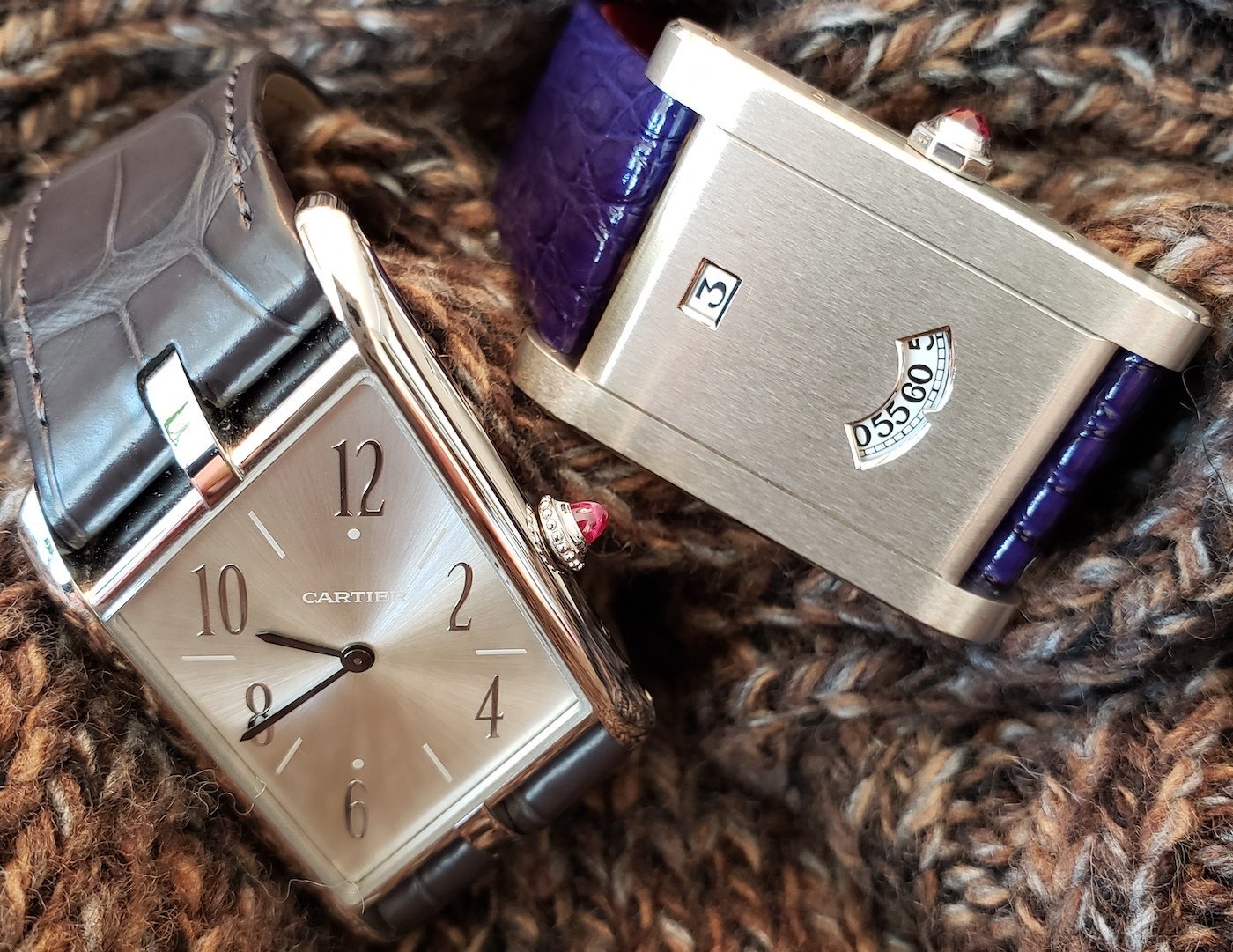
A dilemma with the Nautilus
When asked about the time she devotes to her passion for watches, Jane simply replies: “An incredible amount of time! It’s almost embarrassing. I literally spend my free time at home, when I’m not working, snooping around on the internet, checking out vintage sites or just chatting with other club members.”
What bothers her today is the hyper-speculative side that has taken over some timepieces: “It’s not very nice of me to say, but never mind: I meet a lot of people who are only interested in certain models because they’re fashionable. Of course, the prospect that a watch might lose value has stopped me from buying in the past. But that’s not the ultimate consideration.”
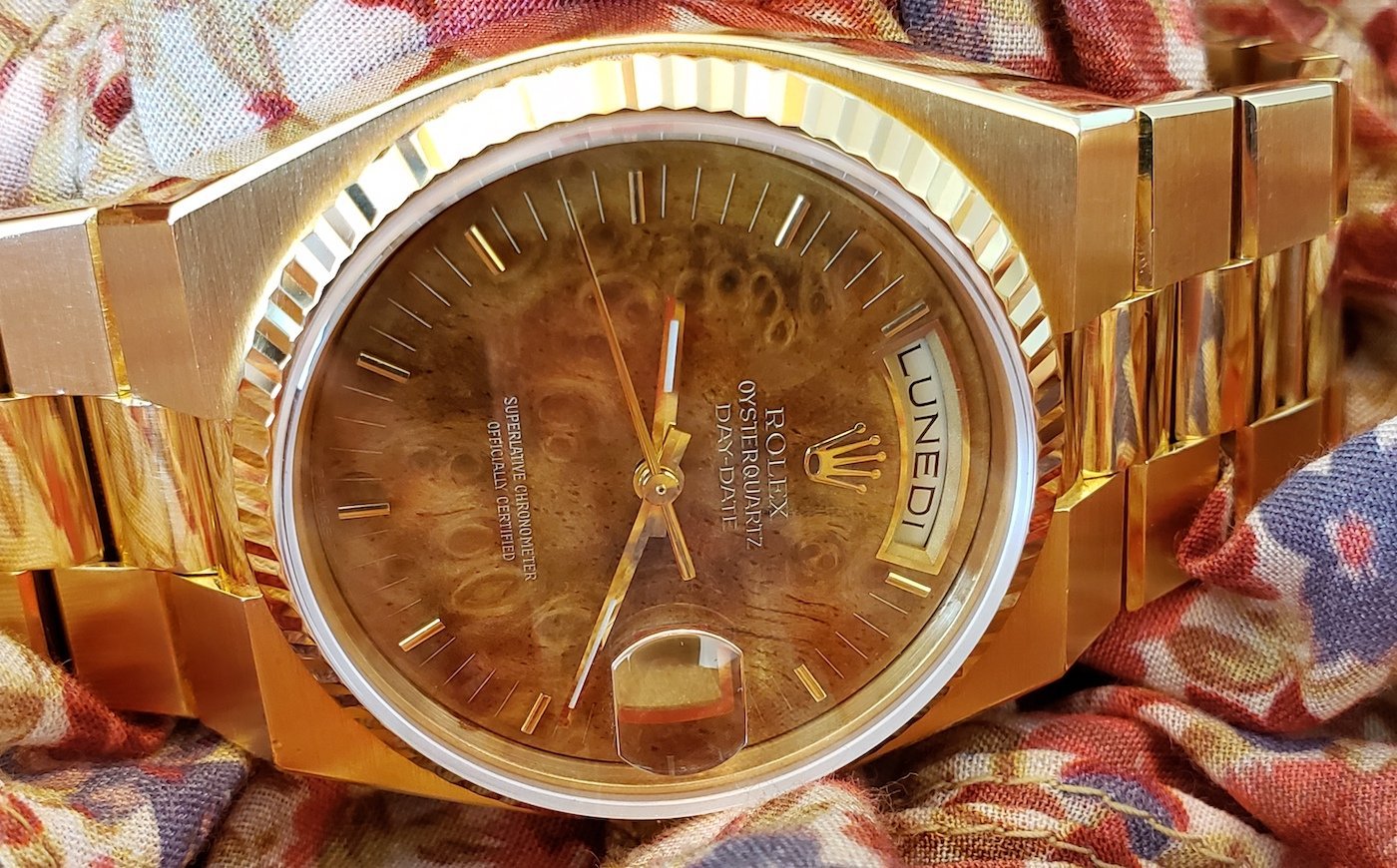
Although she owns a Nautilus ref. 5711, she admits that she rarely wears it. Because of the speculation around the model, it “attracts the wrong kind of attention” and has almost become “risky”.
To feed their passion for authentic watchmaking, The Watch Club Society had planned a tour of the Swiss manufactures in January. The project has been postponed until next year, which at least has the advantage of giving our collector more time to indulge her passion...
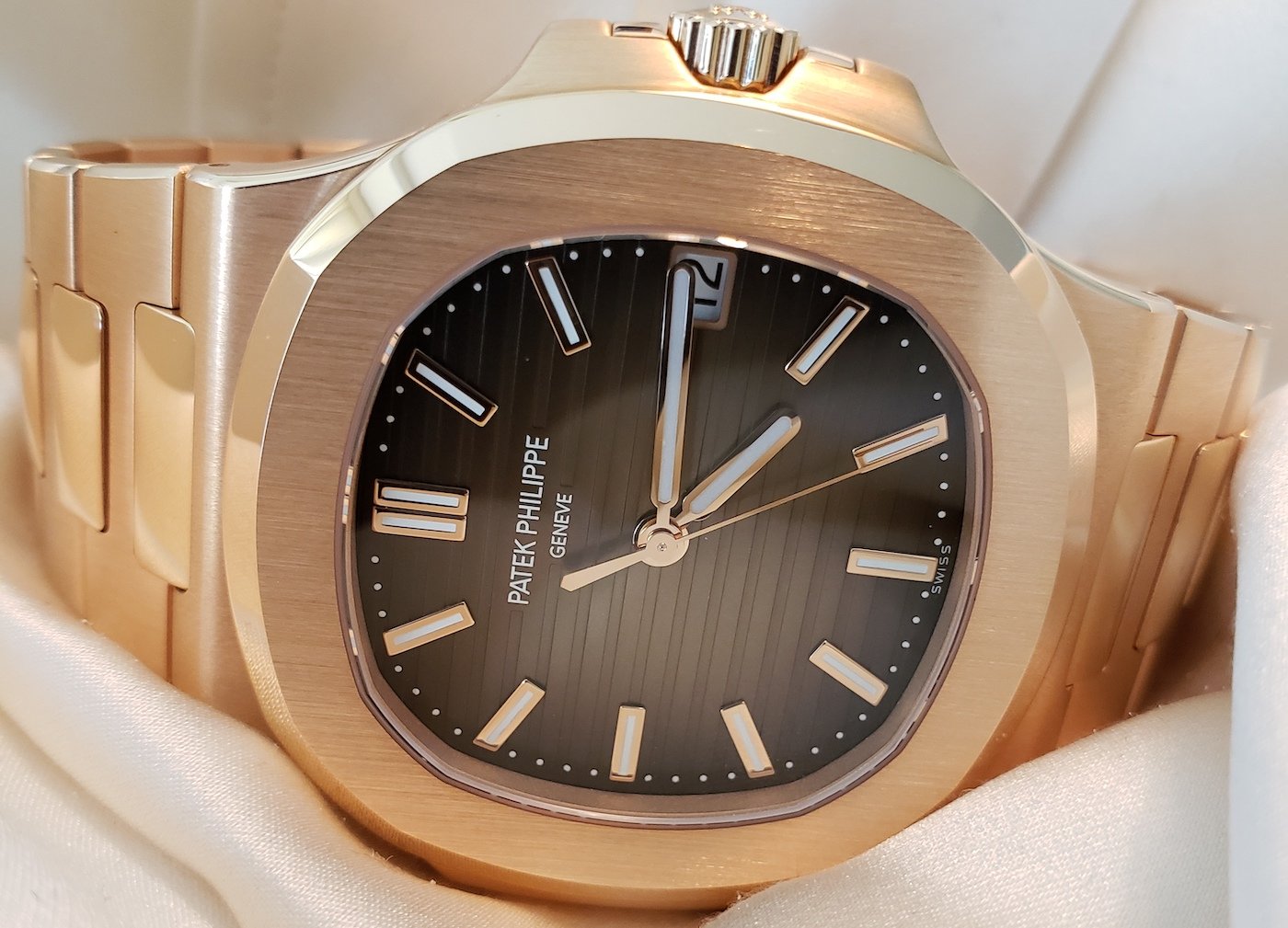

“A predilection for the innovation of the 1960s and 1970s”
or Sy Block, collecting watches is like exploring the branches of his family tree. The New York psychiatrist is in fact related to Gerry Grinberg, whose wife was his first cousin. An emigrant from Cuba to the United States after the Castro revolution, Grinberg was a key figure in the American watchmaking scene from the 1960s onwards. “He started out distributing Piaget and then other Swiss watch brands through his company North American Watch,” says Sy Block. “Among his accomplishments, he revolutionised watch advertising in the United States, modernising promotional campaigns to make the watch an object of style, luxury and status.”
Following the acquisition of Movado in 1983, as well as Ebel and Concord, Grinberg combined his brands into the Movado Group, which remains one of the world’s leading watch companies to this day. The group is currently headed by his son Efraim. In the late 1970s, the American entrepreneur also contributed to the quest for the ultra-thin watch that would culminate in the Concord Delirium IV of 1980, with a record thickness of 0.98 mm, so thin it was unwearable. This research would later lead to the emergence of a popular watch that employed a similar system (where the caseback acts as the main plate), the Swatch in 1983 (of which Sy Block is also a collector).
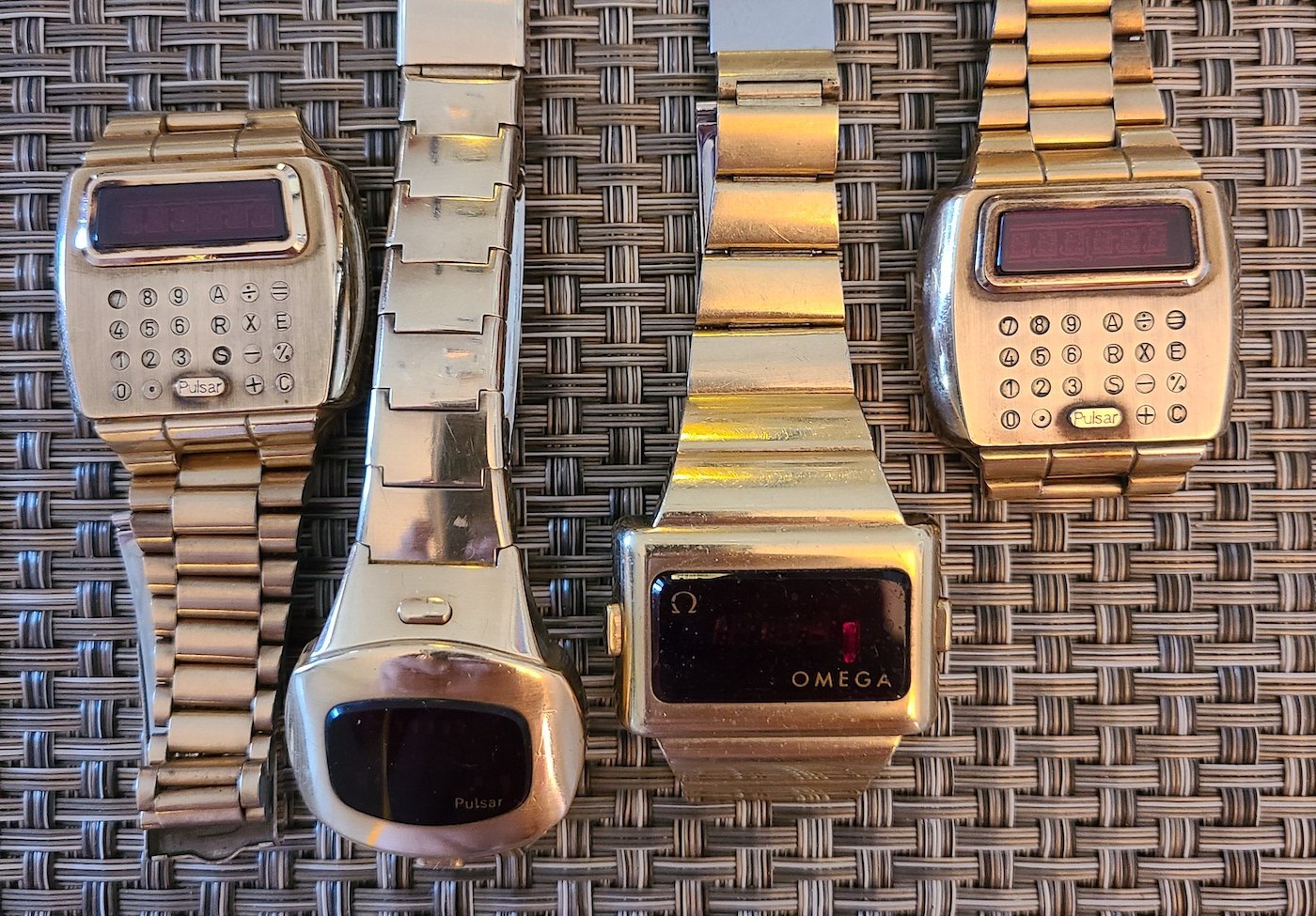
A formative experience
But that’s not the only family connection Sy Block has to the watchmaking world, as he explains: “My father-in-law was Ben Ross of Ross Watch Case, which supplied watch cases to brands such as Rolex, Longines, Omega, Elgin and Bulova.” In order to avoid the heavy import taxes on luxury products into the United States, but also to satisfy local tastes, over the course of the 20th century many Swiss manufacturers developed the practice of sending components (movements, dials, hands) to be assembled and cased locally in the US. Ross Watch Case, based in Long Island City (Queens) was one of the firms that facilitated the export of Swiss watches to the United States for several decades.
-

- Sy Block
One of Ben Ross’s friends, whom Sy Block met as a young man, was none other than Allen Tornek, who in the 1960s imported Blancpain’s famous Fifty Fathoms (for sale to the US Navy, among others) under the name “Tornek-Rayville”, to make it sound more “American”. And Sy Block’s own uncle was a watch retailer in Philadelphia. As a teenager, the now 73-year-old Block often visited him. That was his first real contact with watches, more than 60 years ago. “I used to hang out in his shop and there were a lot of drawers and filing cabinets full of components.”
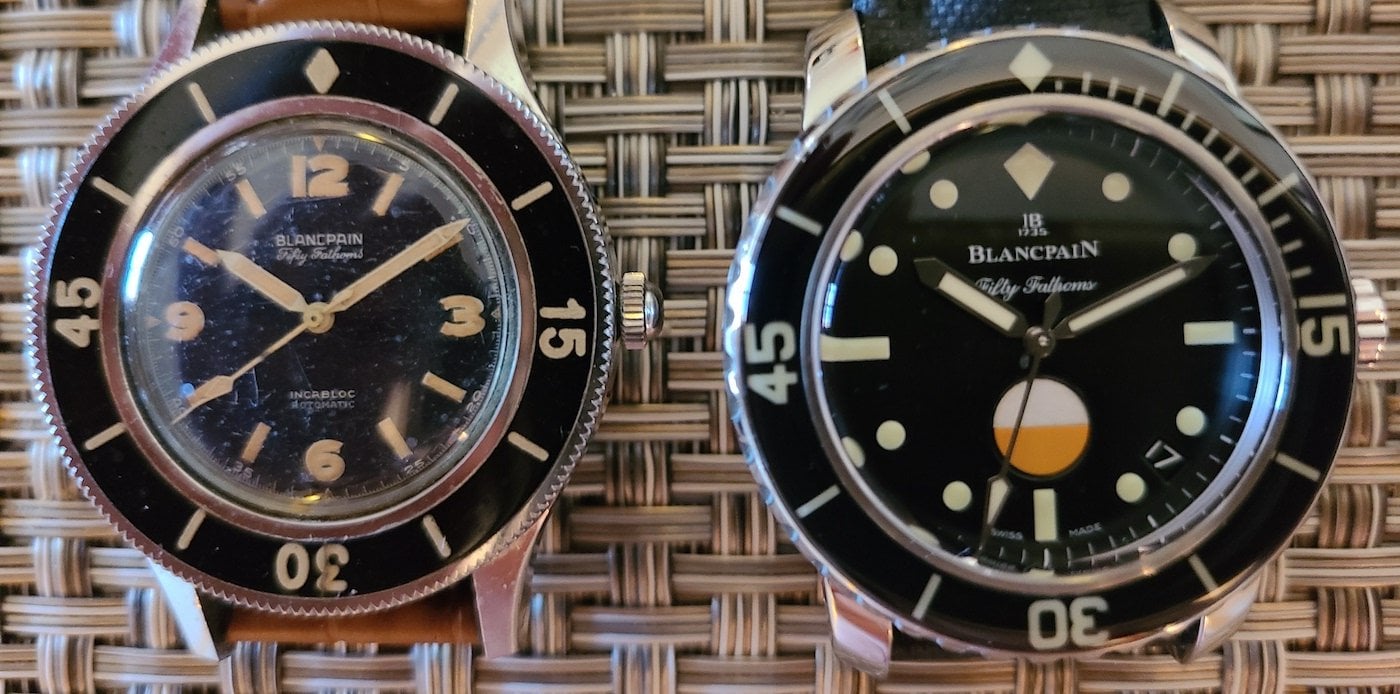
The golden age of digital display
Not surprisingly, Sy Block’s collection includes several models linked to this family history, including an original Fifty Fathoms from 1953 and a more recent Tribute to Fifty Fathoms MilSpec, of which only 500 were produced. The 1960s and 1970s, a period of deep crisis but also of innovation for the watch industry, are particularly popular with collectors today. Sy Block had the opportunity to experience these upheavals from the inside, because of his family ties.
One of the models that best represents this era of transformation has to be Bulova’s Accutron, of which Seymour Block is an unconditional fan: “It was my childhood, I remember the Spaceview commercials very well.” He is also very fond of the Hamilton Pulsar, of which he owns several examples, as well as the Omega Constellation Time Computer dating from the golden age of digital display in the 1970s.
“What interests me most, whatever the era, is the design,” says the collector. “I appreciate everything that is out of the ordinary, such as hybrids between different influences.” Another model dear to his heart is the ultra-precise and pioneering Girard-Perregaux quartz calibre 350 that developed into the Beta 21 (considered the grandfather – or grandmother, depending on your point of view – of quartz movements, with an impressive 32,768 Hz frequency). A decade earlier, the brand had already contributed to improving the precision of automatic movements with its Gyromatic Chronometer HF, of which Sy Block owns an original model.
“I appreciate everything that is out of the ordinary, such as hybrids between different influences.”
For his profession as a psychiatrist, the question of “time” is obviously central. His collection helps him to somewhat conceptualise this abstract notion in a rather eclectic way. One watch stands out at the top of his collection in terms of prestige: a Patek Philippe annual calendar in pink gold. “An aesthetic summit,” according to Sy Block. In the same classic vein, he also owns an automatic Audemars Piguet with the gold woven bracelet his father-in-law Ben Ross used to make, as well as an IWC Portugieser in rose gold.
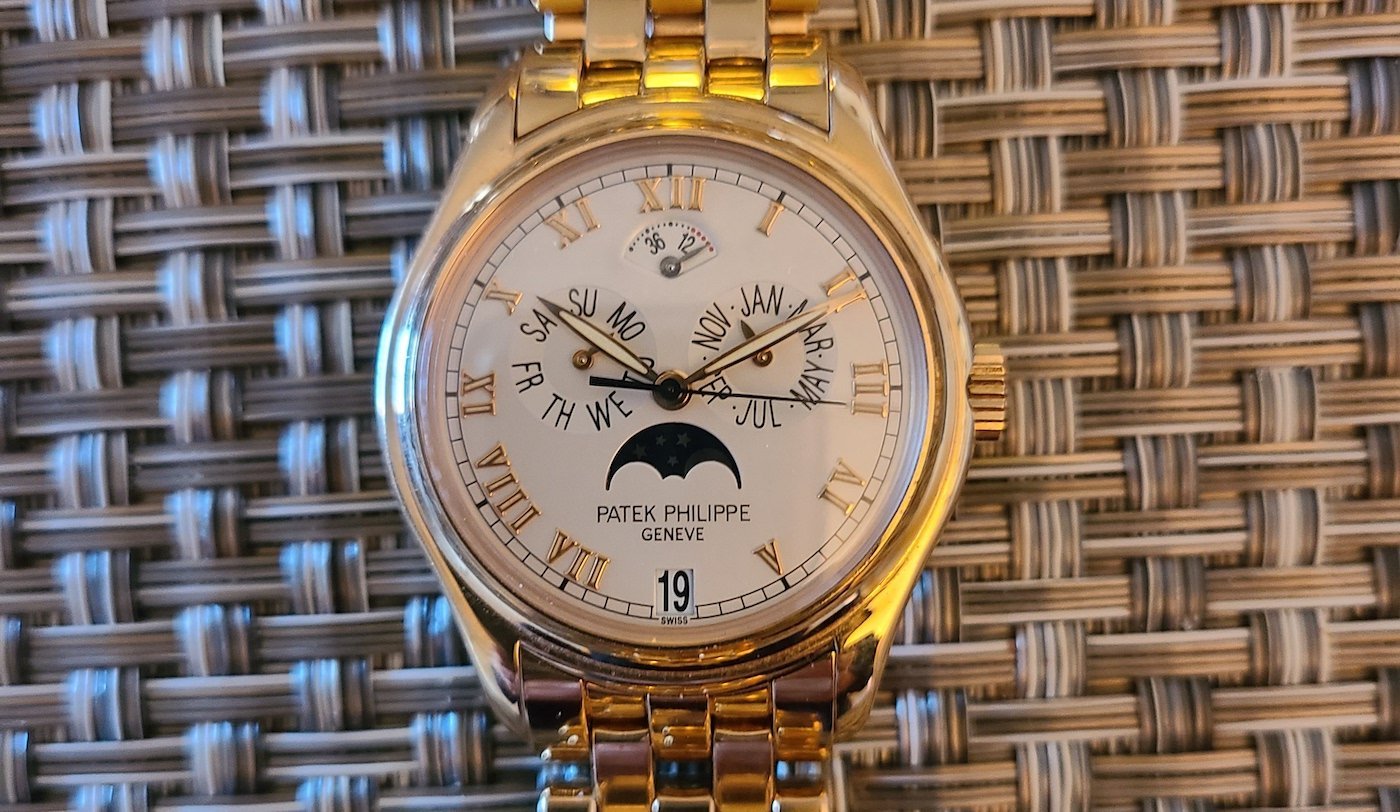
A very special private label
Sy Block shares another hobby with many of his peers: collecting vintage cars. He owns a 1963 Sunbeam Alpine, a 1967 Sunbeam Tiger and two Volvo 1800s, one of which he bought new in 1972. Further evidence of his eclectic taste in horology is that his passion does not end with wristwatches: Sy Block owns several desk clocks (including an Art Deco model and two Accutrons), marine deck clocks (including a 1942 Hamilton made for the US Navy), as well as an original Seiko liquid crystal chronometer from 1967. Regarding the latter, he says: “Not only is it working, which most are not, but it is as accurate as my radio controlled Sharper Image atomic clock.”
Six of his family members own the same Seiko automatic chronograph, which he made sure to offer them. “The original beauty of this watch is that it has never been touched by a watchmaker, as it was entirely machine-made,” says Sy Block. He has one final secret: a model he designed... himself. He explains: “My father-in-law owned several Ed. Koehn movements from 1909. I gave one to a retailer but he lost it... To avoid any further problems, I called the watch expert Phillip Poniz to see what we could do with it and if it was possible to fit this movement with a suitable case.”
As Ed. Koehn made movements for Audemars Piguet, the two men used the brand’s coffee table book, which they both had, as a reference, taking inspiration from a number of different models. “The case, when polished correctly, should be matt finished in the inner area and bright finished on the outside panels,” the collector points out. The result was a jumping hour model using a platinum case and an Ed. Koehn move- ment. It is utterly unique.
This ability to bring old models back to life and to see a movement once more ticking away inside its case, a form of “resurrection”, is what makes the life of a watch collector so special, for Sy Block as for many others.
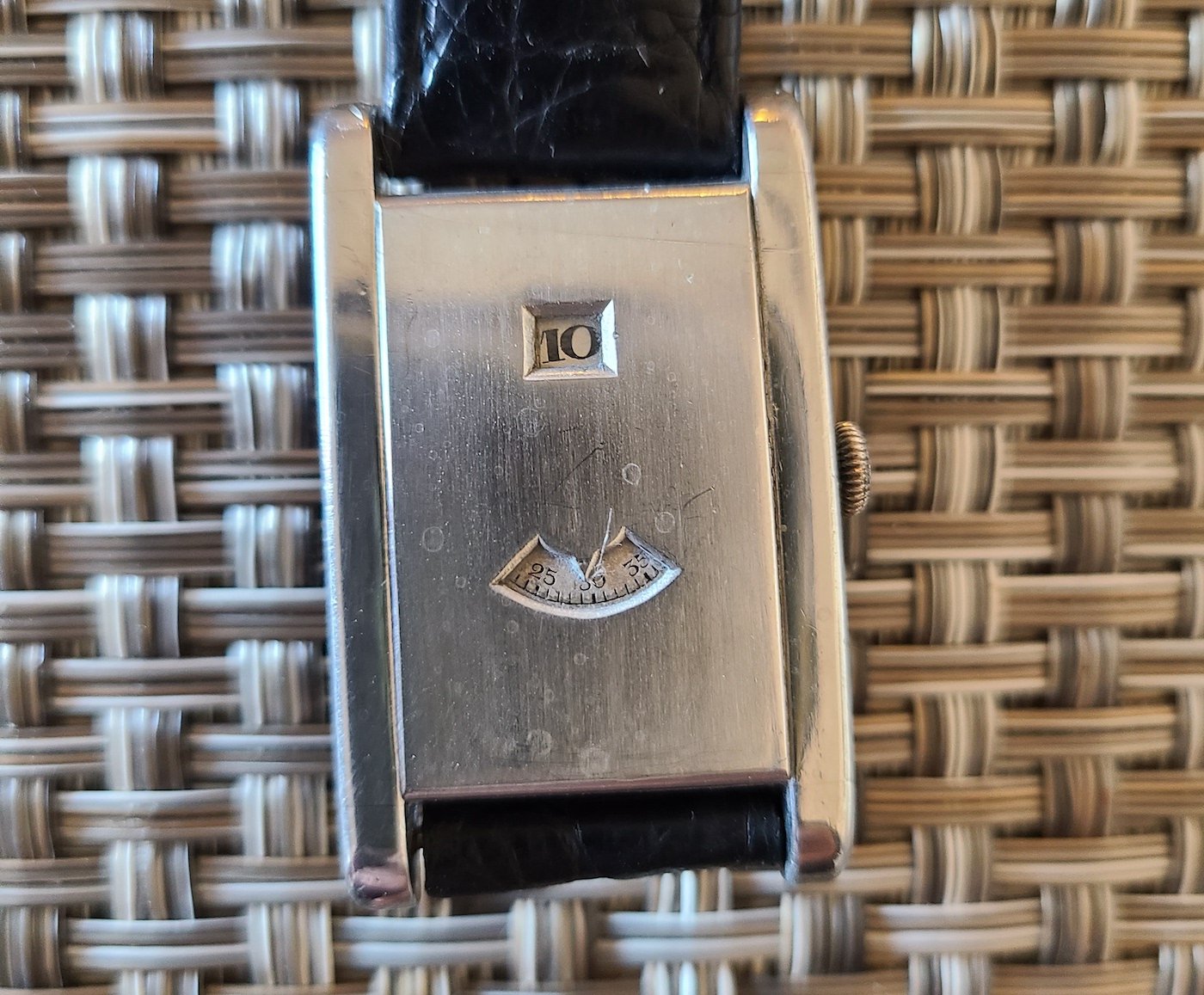

Redbar: uniting collectors worldwide
e had the chance to see Adam Craniotes in action during a watch event earlier in the year at the Montblanc store in Aventura, north of Miami. The RedBar founder, widely recognisable with his New York accent, energetic outspokenness and thick beard, was presenting the new SIHH offerings from the Richemont brand to a panel of visitors. There’s no doubt that Montblanc’s neo-vintage style, initiated under the watchful eye of Davide Cerrato (read his interview here), has won over this community of watch enthusiasts.
We saw Adam Craniotes again, more recently this time, at the CoutureTime show in Las Vegas. He was there to host the first annual national American meeting for RedBar as well as panels on the state of the watchmaking industry and the perspective of the contemporary watch collector. He was also tasked with attracting end buyers – increasingly courted by brands themselves – to the show which was previously a retail-only affair.
And we can expect to see him ever more frequently in the watchmaking hotspots as his community of collectors grows, united by an informal, expert spirit. As we are introducing a ‘Vintage & Collectors’ section to Europa Star, we simply had to find out more! Encounter.
-

- Adam Craniotes, RedBar’s founder
When and how did the RedBar adventure begin?
In 2006, in New York. The internet had really begun to take off in the watchmaking industry at the time. I was already reading Timezone forums in the 1990s but the internet achieved a sort of maturity in the 2000s and sites such as Watchuseek, Ablogtowatch and Hodinkee began to emerge.
With the internet, we saw a proliferation of watch information online and a ’freedom of speech’ among customers and collectors.
One day, I met another collector, Jeffrey Jacques, and we discussed continuing the conversation offline rather than talking online. We went to a bar that we found in Koreatown – Red Bar, which no longer exists. And we decided to meet up there every month! Nowadays, New York meetings take place weekly at a secret location in Koreatown.
So you have paradoxically exploited the internet boom to revert back to physical meetings!
The irony is that the internet has allowed the ‘physical’ meetings to grow in terms of both the watch business itself and our meetings. Then Instagram arrived and we launched the #redbarcrew hashtag, which has attracted a lot of attention. But some are tired of doing everything online. A group of collectors and enthusiasts can talk for hours so better that we do it face-to-face, watch on wrist!

THE ORIS DIVERS SIXTY-FIVE REDBAR: The independent Swiss brand partnered with the collectors’ club to launch a special 40mm version of the Sixty-Five Oris watch, with bronze bezel, gold hands, gold indices, and of course… a remarkably red dial. The watch has a definitive vintage appeal. It was introduced at CoutureTime in Las Vegas last June, is priced at $2,100 and is limited to 100 pieces.
So is it also a platform for exchange, loans or even the sale of watches among members?
Many people exchange or even sell watches through the club. We publish a list of watches for sale but it’s not a business and we earn no commission. It’s a good thing you reminded me because it’s a while since I’ve seen a Rolex I lent to a RedBar member!
Is it your job now?
Yes. When I started RedBar, I was a copy director at Macy’s, I wrote for iW Magazine and Gear Patrol and I was a forum moderator on the Timezone site, especially the IWC forum. But I gradually felt better and better during RedBar meetings and worse and worse in my everyday work.
Two years ago, I took the plunge and officially launched the RedBar Group which now operates in 40 cities on four continents. We also established the RedBar Fund, which supports charitable work.
What is your business model?
Members do not pay a subscription fee and we are committed to keeping the club free. We earn money from partnerships with brands for whom we organise events and provide consulting services. We partner with shows such as CoutureTime. We’ve also designed watches with Maurice Lacroix and Oris.
What do you give to partner brands?
It’s about visibility but not direct sales. I never promise to sell a certain number of watches during an event. It’s about access to collectors and that’s a more emotive subject.
How has RedBar grown?
People outside of New York gradually began to contact me as they wanted to organise the same initiative in their city. I was contacted today by someone wanting to open a RedBar branch in Buenos Aires. We’re in the process of opening branches in Geneva and Basel, as well as in Tokyo!
What are the criteria to open a local RedBar branch?
The branch managers must be charismatic and inspire the people they bring together. Most important is that the atmosphere be laid-back. RedBar has already played matchmaker twice!
How do you become a member?
The only requirement is to be a watch enthusiast. Some people don’t yet have a timepiece when they start coming to our meetings. You know, when you say that you’re a watch collector, people’s first reaction is often to take you for a rich person or a fool. Or a rich fool! But a group of collectors and enthusiasts can talk for hours. The ’cost’ factor is irrelevant.
You’re a collector yourself. What was your first watch?
A Casio F-7 series digital model. I received this watch from my grandfather and gave it to my son on his third birthday. As such, his first watch was also my first watch! Passing down through the generations is not exclusive to luxury watches…

Collecting watches: a meeting with Lung Lung Thun
t a time when the world in general (and the watch world in particular) is going through rough and transformative times, we had the opportunity to meet Hong Kong-based watch collector Lung Lung Thun.
Her first watch was a Chanel J12, which she bought after graduating from college in the UK. A few years later, after moving to Hong Kong (on the Kowloon side), she discovered the fantastic world of vintage and second-hand shops, and the browsing started...
In 2016, she acquired a vintage Audemars Piguet in yellow gold with an annual calendar and moon phase. Her love for the brand grew in 2018 as she took possession of a frosted gold AP limited edition, designed in collaboration with the Florentine fine jewellery designer Caroline Bucci.
Although the horological world is slowly opening up, it is still unusual to come across female watch collectors. What does she look for in a timepiece? Here are some of her refreshing insights on watch collecting.
-

- Lung Lung Thun
What was the first watch in your collection?
I had wanted a Chanel J12 since my first year at university. Back then, in 2007, there was a lot of heavy marketing for both J12 watches and 2.55 handbags, and I was convinced that was the way to go. I was still discovering my own taste and style. When I graduated from university and went back to Singapore, I decided to buy a J12 to celebrate my first job. But it was only a first step: at the time, I couldn’t have told you exactly why I needed that watch in my life!
So I started to hunt for another timepiece. And that’s how I found Audemars Piguet. It was love at first sight. I liked the history and vision of the brand, the people, their watch designs, and the fact that the design of the Royal Oak was somewhat masculine, which reflects my personality well. My first AP was a purple Ladies’ Chronograph Offshore.
“With Audemars Piguet, it was love at first sight: I liked the history and vision of the brand, the people, their watch designs, and the fact that the design of the Royal Oak was somewhat masculine, which reflects my personality.”
How did you develop your taste in watches?
I like precious metals such as rose and yellow gold. I did go through a Daytona phase, but I got it out of my system eventually (laughs). Now, I purchase with a clear direction and purpose. My favourite complications are perpetual calendars, or at least a nice moon phase.
I love the Royal Oak, as it is masculine and sporty, yet you can still make it look feminine with a few twists. There is a lot of history that can be traced back to understanding how the shape and design of the timepiece have evolved. I’m also very interested in A. Lange & Söhne, which I feel is a reflection of my deeper understanding of movements, and I also like the philosophy of MB&F.
Most of your collecting timepieces have quite intricate dials...
I have always been drawn to “loud” watches. I enjoy dressing simply and letting the watch do the talking! A fine watch is essentially a piece of art. I like the challenge of fitting so many details onto a watch, yet balancing it so it still pleases the eye.
“I have always been drawn to ‘loud’ watches. I enjoy dressing simply and letting the watch do the talking!”
Do you also collect timepieces as a reminder of certain memorable events or experiences in your life?
Not really! But there is one exception. After I moved to Hong Kong in 2017, I purchased a watch that didn’t come from an authorised dealer for the very first time. I wasn’t used to negotiating and searching for specific pieces, so I must say it was an experience that really excited me. This timepiece will always be part of my collection because of the memories it holds.
I don’t necessarily buy pieces to mark occasions. I’m constantly on the lookout for my next watch, and sometimes these searches can take months. I mostly use watches as a way to motivate me to work towards my goals!
What can you say about the evolution of the local collecting scene in Hong Kong, following the pandemic outbreak?
I am very lucky to be in Hong Kong, because people really love watches here. Nothing has really changed as far as the enthusiasm for collecting is concerned, and there are still waiting lists for “blue chip” watches. I do, however, miss having huge get-togethers with my watch collecting friends. Thankfully we can still connect through WhatsApp group chats.
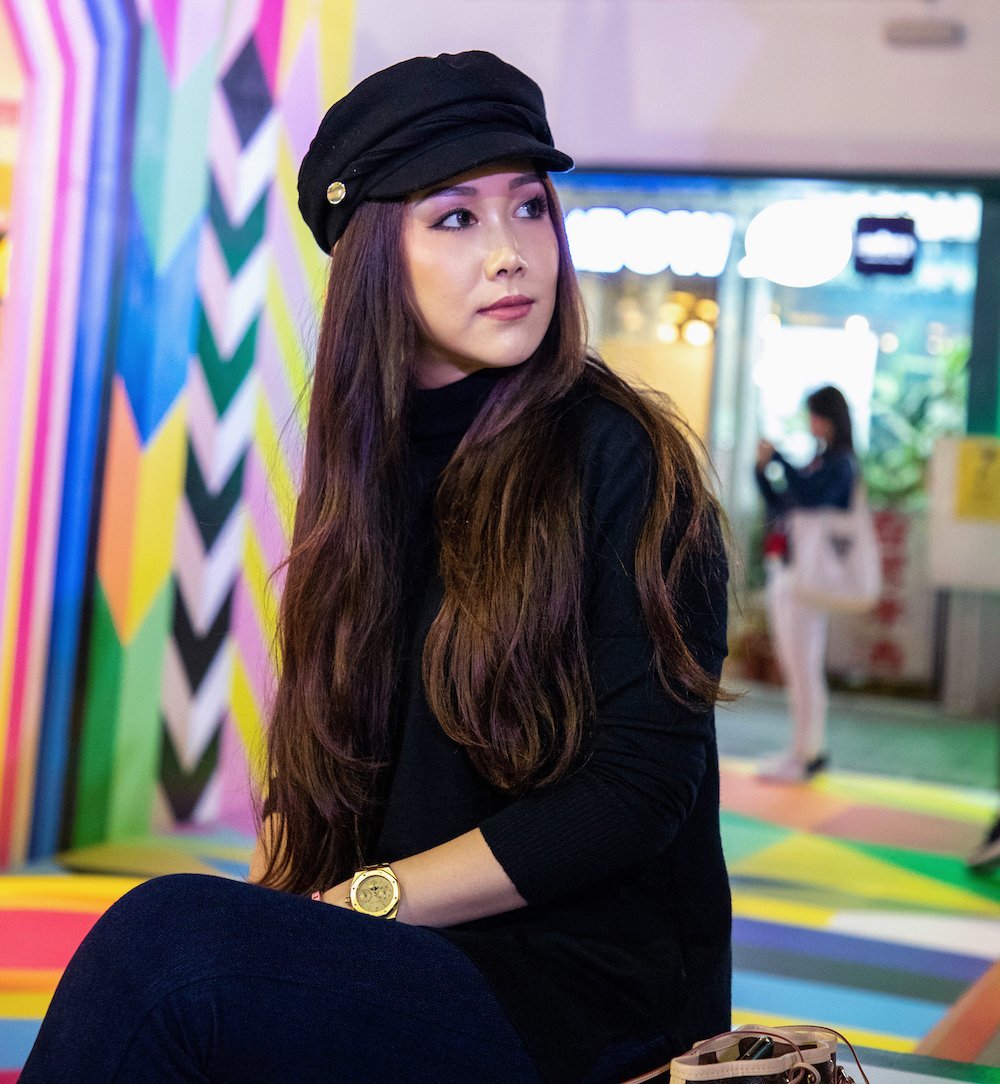
What pieces are you currently on the hunt for?
I must say that I am still on a high from my latest purchase, which took me a few months to hunt down! I am currently drawn to vintage pieces with smaller cases. I’m keeping my fingers crossed that by the time this interview comes out, I will have found and be holding my next piece...
What is your impression of retailers’ attitudes towards female collectors?
There has been a huge shift in customer experiences in the past year. Retailers are listening more to female clients, in terms of what their preferences are, and they are creating events that are both interactive and educational. However, there is still a huge need for watch communication to become more diverse, more “real”, and to feel relatable to women from different regions and backgrounds.
What is the future of Hong Kong as a watch hub, given the current political challenges?
I actually don’t think too much will change: if you look at recent auction turnout and results, the pandemic and the political climate have not deterred the enthusiasm of collectors here. However, you can see that mainland Chinese are relying less on purchasing from Hong Kong.
“There is still a huge need for watch communication to become more diverse, more ‘real’, and to feel relatable to women from different regions and backgrounds.”
What is your opinion of the new watch hub being created on the island of Hainan?
I love it. I have always welcomed competition because I think it spurs innovation and pushes everyone to work harder and to deliver more. This is good for collectors. I also think that watches have become increasingly hard to access, and having more channels for people to enjoy this hobby can only be better for the industry as a whole.
Looking at the watchmaking industry, what would you wish to change?
It would be great if brands could provide prototypes for people to try directly in the stores, so as to give them a first feeling of the timepiece and decide if they want to be on a waiting list, rather than purchasing it directly. Also, I find that marketing at the moment is very unclear and highly confusing, although there are a few brands, like Patek Philippe, that have clear communication that makes sense in terms of handing over to the next generation.
Maryanne Maina is a luxury concierge consultant and writer based in Paris, France, and Nairobi, Kenya.

Meeting the Shanghai Watch Gang
he Shanghai Watch Gang represents a new stage in the development of watch expertise in mainland China. Groups of collectors are starting to come together. As with many Western groups, they are highly connected, and they met online first, discussing a wide range of horological topics, before organising regular physical encounters.
Many of the founders, including Kelvin Sa and Daniel Sum, are what we could call “international Chinese”: they were born or studied abroad. But we’re also seeing more and more mainland Chinese joining their ranks.
-

- Andy Zhang (creator of #LangeNation), Daniel Sum and Kelvin Sa, the founders of the Shanghai Watch Gang. Austen Chu (aka @horoloupe on Instagram) is also a founding member. Meanwhile, Andy Zhang has been appointed Client Director for Greater China by A. Lange & Söhne in China.
Organic initiative vs. boutique events
“The Shanghai Watch Gang today numbers 300 members, mainly based in Shanghai. Most are local Chinese and a few international people living here have also joined the Gang,” explains Daniel Sum.
The group, which has a particular fondness for German brand A. Lange & Söhne, decided to organise a watch festival, and the inaugural edition took place last year. The German brand was the leading exhibitor, along with representatives of the best of the contemporary independent watch scene, such as Greubel Forsey, Urwerk, Vianney Halter, De Bethune, Manufacture Royale, H. Moser & Cie and Thomas Prescher.
“Brands have trouble gathering a dozen credible collectors for their boutique events, while people fly from all around the world to attend our yearly Shanghai Watch Festival!” states Kelvin Sa. “We tell the guests it’s an introductory event to the brands and the horological world, not a selling event. We live in the age of soft power: a non-selling event is the way you sell now!”
What is the Gang’s aim? “Our purpose is to contribute to the growth of the Chinese watch market, by translating the casual spirit of the Shanghai Watch Gang into the Shanghai Watch Festival. Last year, each of us sold one of his timepieces to organise the first Festival. That’s how passionate we are!”
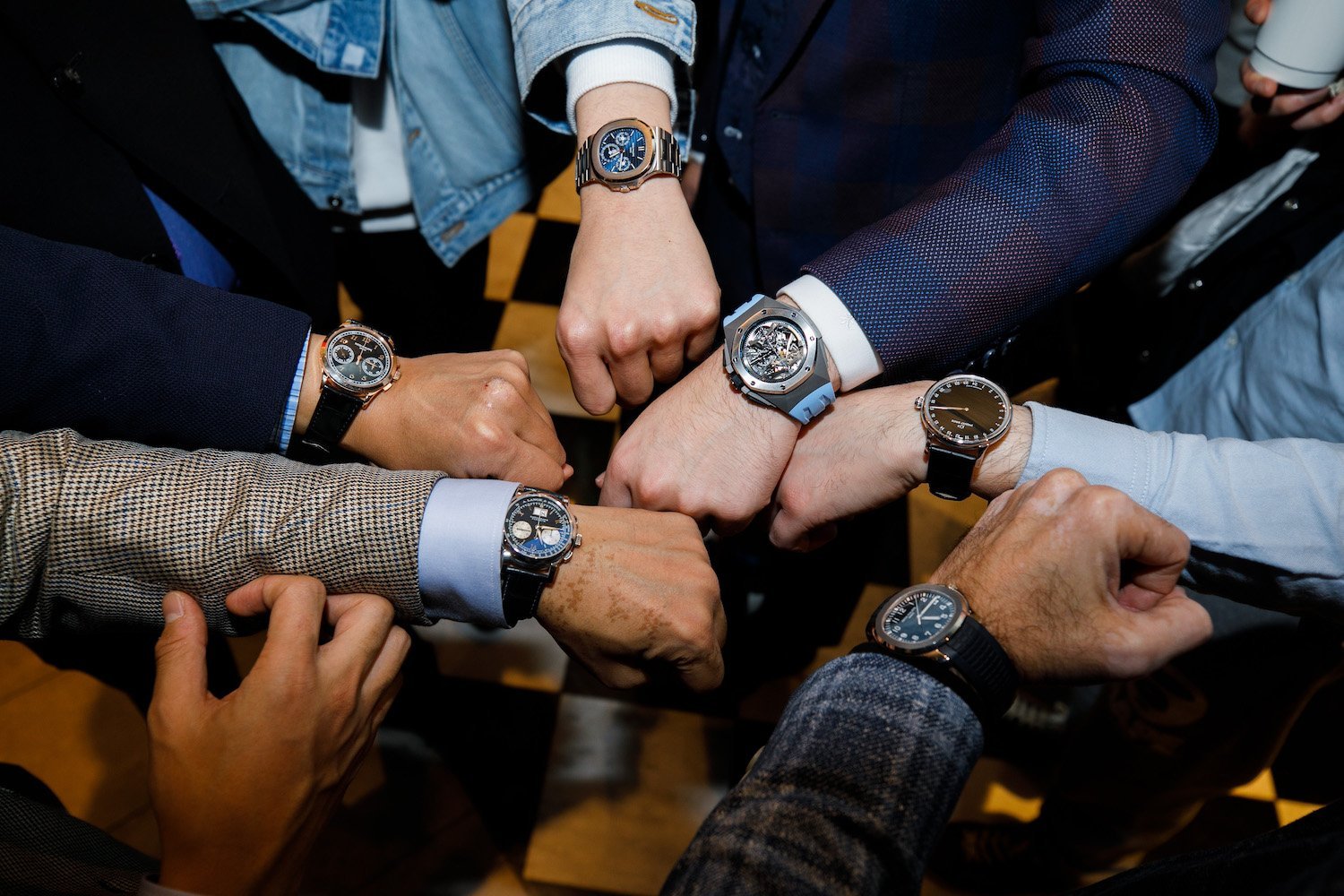
New festival in December
A second event will be held this coming December (Europa Star is a media partner of this year’s event). With the major change in the horological agenda next year, “it’s the ideal place to launch new releases for the Chinese market, as SIHH and Baselword will happen so late,” argues Kelvin Sa. The group is expecting major players to attend this year.
To further translate the spirit of the collectors’ club into reality, the Gang also just opened a watch-themed bar in the district of Jing An. “We would be happy to host events for watch brands, fans and collectors,” says Kelvin Sa. “It’s a very appealing place, while in Nanjing Road, the luxury hub of the city, you have very low foot traffic in the watch boutiques. It’s depressing. In Chinese culture, if you enter a store and don’t buy, you might lose face. There is no more reason to go to a store really, if not to pick up a watch!”
We first met the Gang while they were visiting Baselworld this year. ”We noticed that people like the Basel fair because it doesn’t have the atmosphere of a boutique,“ Daniel Sum adds. “You come to discover the latest releases while drinking a cocktail. It is cosy so it creates a soft introduction to horology.”

“Take Chinese customers seriously”
The Gang also recently launched a consulting firm which specialises in helping watch brands ‘translate’ their strategies for mainland China. “The key element to succeed in China is trust,” says Kelvin Sa. “The Chinese buy through recommendations of friends. Keep in mind that WeChat is a closed platform. But brands often get partnerships with the wrong KOLs. You can buy a lot of followers on Instagram, China is worse than the West as far as fake followers are concerned. Moreover, brands are losing money by investing on Weibo! We only use it for gossip today, and it doesn’t fulfil the objectives of luxury brands.”
For them, another problem is that Swiss watch brands have long taken Chinese consumers for fools, dumping their less attractive timepieces from Europe at high prices. “It has long been the end market for unsold inventories from the rest of the world. This system worked as the practice of gifting was popular in China. You just looked at the name and the amount of gold… Now that has all gone, the middle class is growing and people are buying for themselves. It is the right moment for watch companies to build up their long-term branding and credibility in China, unlike what happened in the past.”

Collective: the Silicon Valley’s watch club
he idea of Collective was launched at the end of 2018 in Silicon Valley by two watch enthusiasts working in the tech industry, Gabe Reilly and Asher Rapkin. They partnered with Rob Caplan, owner of reputed Bay Area-based Topper Fine Jewelers, to create not only a new forum for local horology aficionados – they have a private discussion group on Facebook – but also a 360° platform that goes from organising exclusive events for the group to creating one-off timepieces with watch brands.
The main idea of the first collaborative watch with Zenith was to create “a version of the El Primero that would be inspired by the design language of Silicon Valley.”
-

- Gabe Reilly, co-founder of Collective
They came to our attention when Zenith announced the launch of a “Collective” edition of its Chronomaster El Primero last October. So it seemed like a good idea to meet Gabe Reilly, to find out more about this fledgling club.
“The beating heart of our 50-strong group is made up of people who work here in the tech industry,” he told us. “Whether they are product designers, software engineers or copyright attorneys, they love watches for two main reasons. One is the romance of mechanical timekeeping. The other element is a reverence for the contemporary technological side of innovation in watchmaking, like the Spring Drive by Grand Seiko or the Defy by Zenith. Hence we love quartz too, unlike many whose default reaction is negative!”
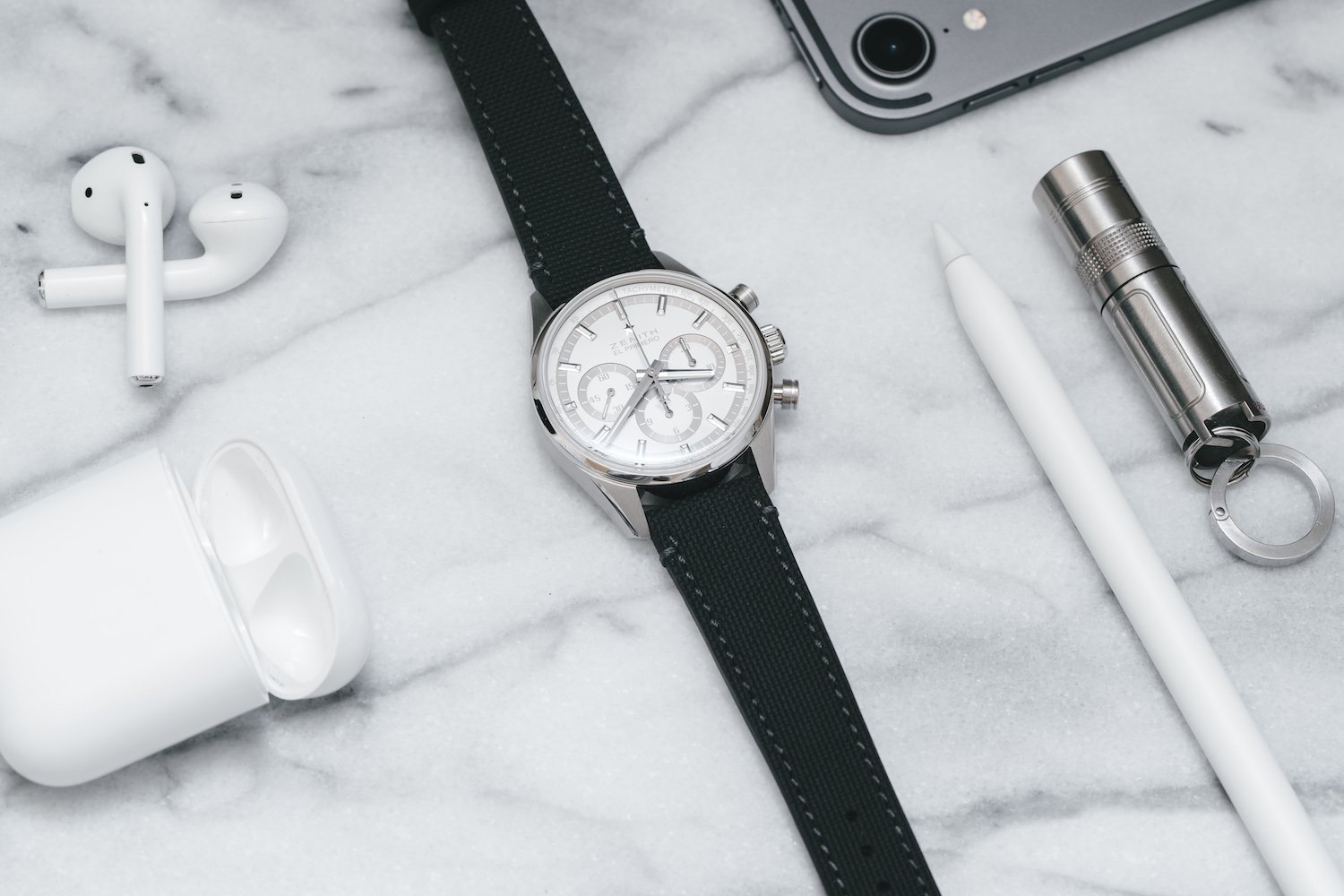
“The club was largely born out of frustration,” he continues. “The passion of the community is growing but some watches are harder and harder to get. It’s not only about the ‘usual suspects’ – their shortages create a ripple effect for the industry as a whole. That can be really frustrating, because you feel you are being left out: some people who jump the line get these watches and it seems unfair. By combining the power of 50 people, we can build the watches we want with the brands we like.” The main idea of the first collaborative watch with Zenith was to create “a version of the El Primero that would be inspired by the design language of Silicon Valley.”
“The leap from software to hardware made us nervous, as it was new for us to commit to something that we couldn’t come back from.”
Although the initial stage of the process was “very comfortable” in terms of the creative concept and design, things got more difficult when they moved to the prototyping stage, as Gabe Reilly explains. “The leap from software to hardware made us nervous, as it was new for us to commit to something that we couldn’t come back from. In our daily jobs in software, we can test fifteen versions of the same thing to see which one works best. We realised we had to make a leap of faith. But knowing the outer limits of your abilities is essential so we wouldn’t micro-manage the process.”
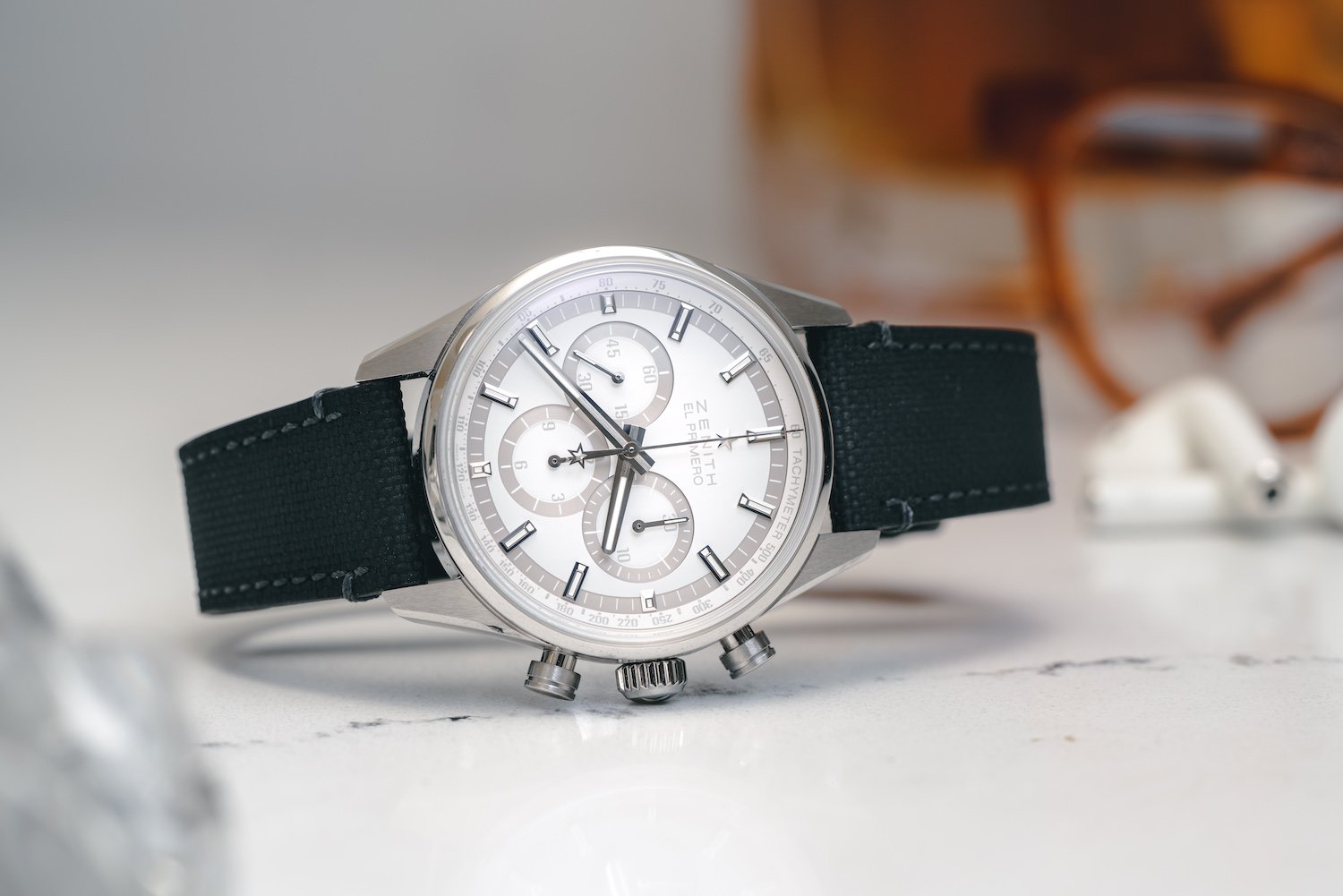
We couldn’t resist asking Gabe Reilly, a tech executive with a passion for timepieces, about his vision of the future of the watch industry. “Just like Kickstarter and other new tools of distribution, we are a part of a new way of buying watches – through a club. People love mechanical watches in Silicon Valley. At the same time, I would like to see more openness from the traditional watch community itself to smartwatches and connected watches – in the same way as we have a reverence for the Spring Drive, quartz, ceramics or any other innovation coming from the watch world. After all, if Hans Wilsdorf were alive today, with his innovative spirit, he might well have worked here in Silicon Valley!”
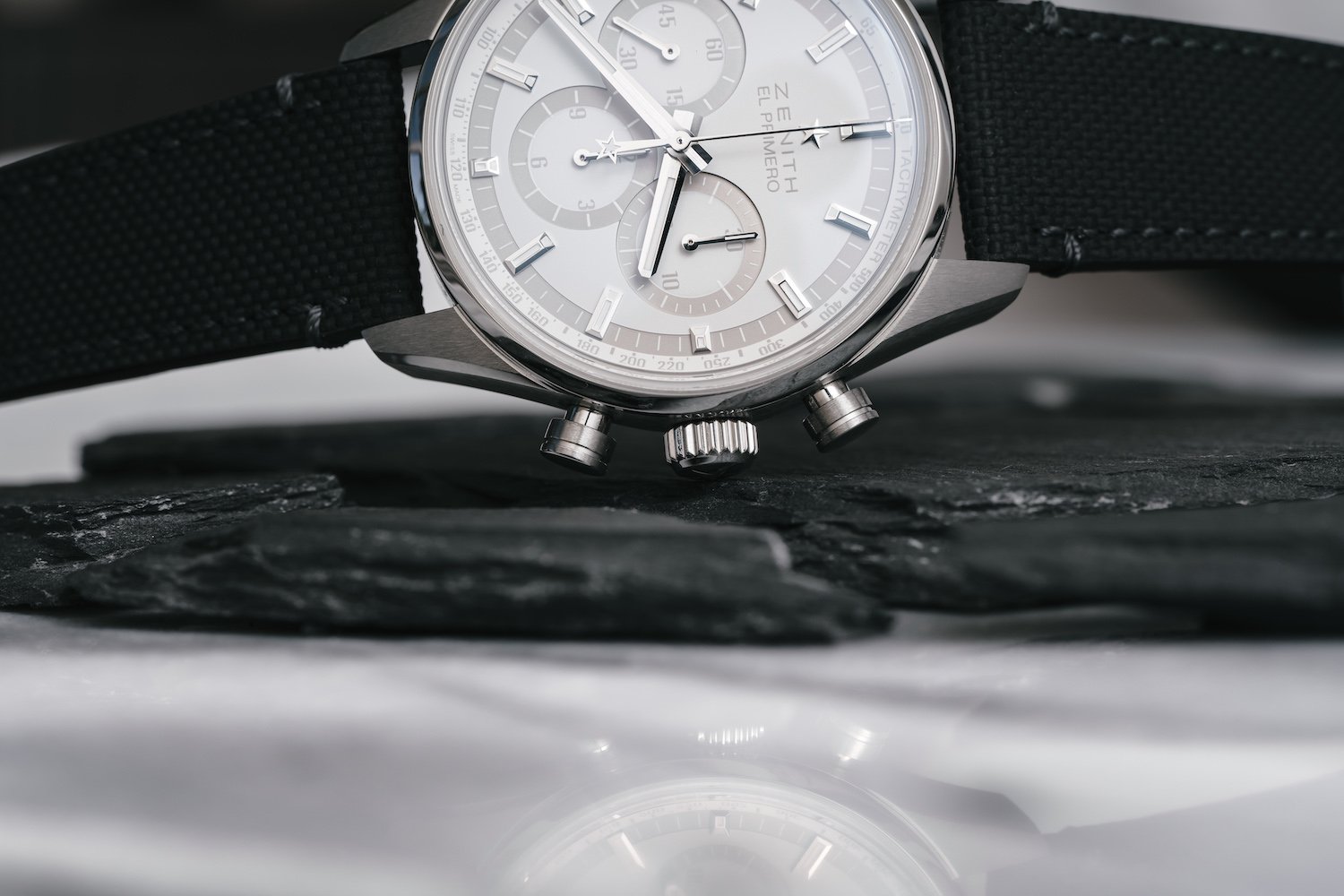
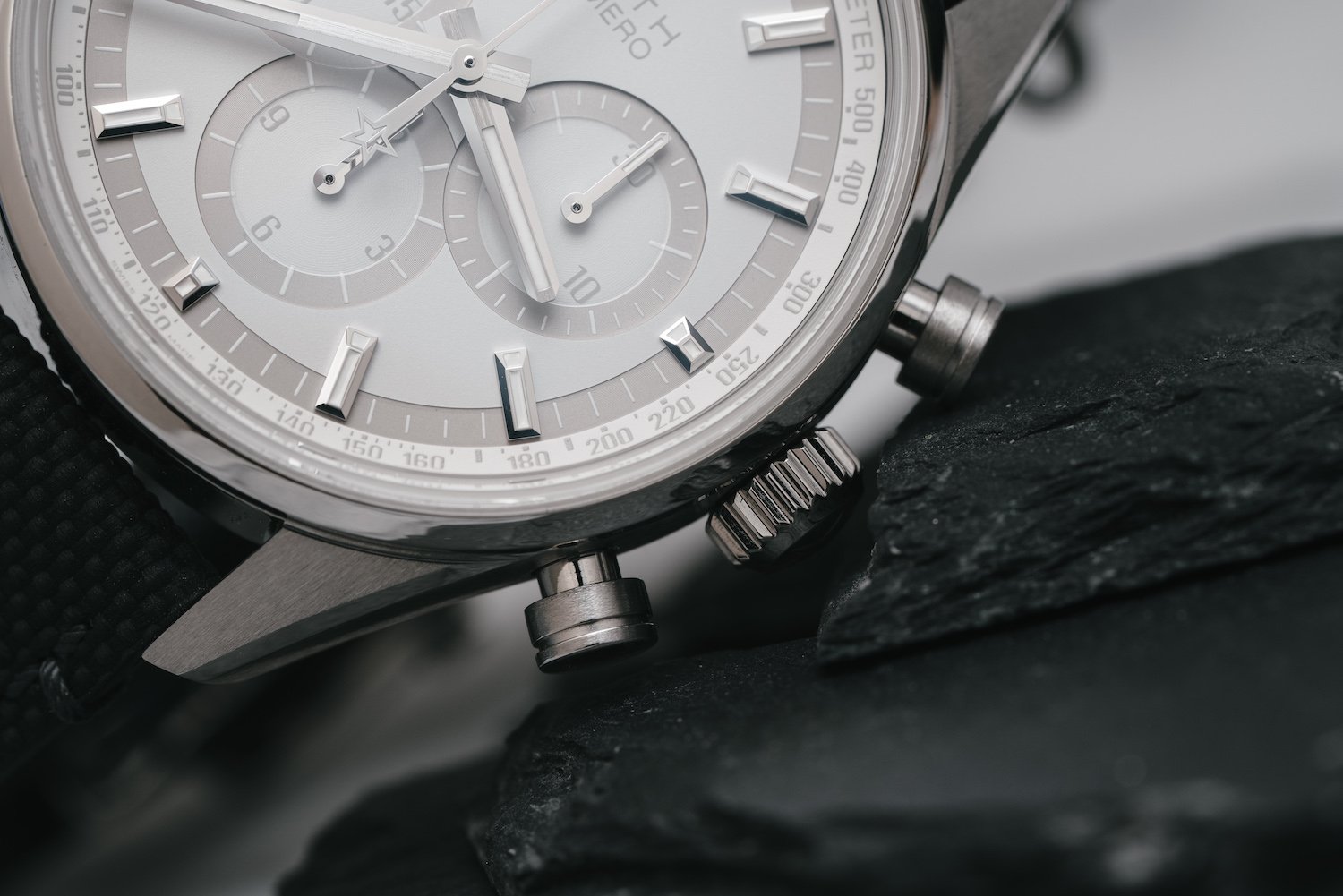
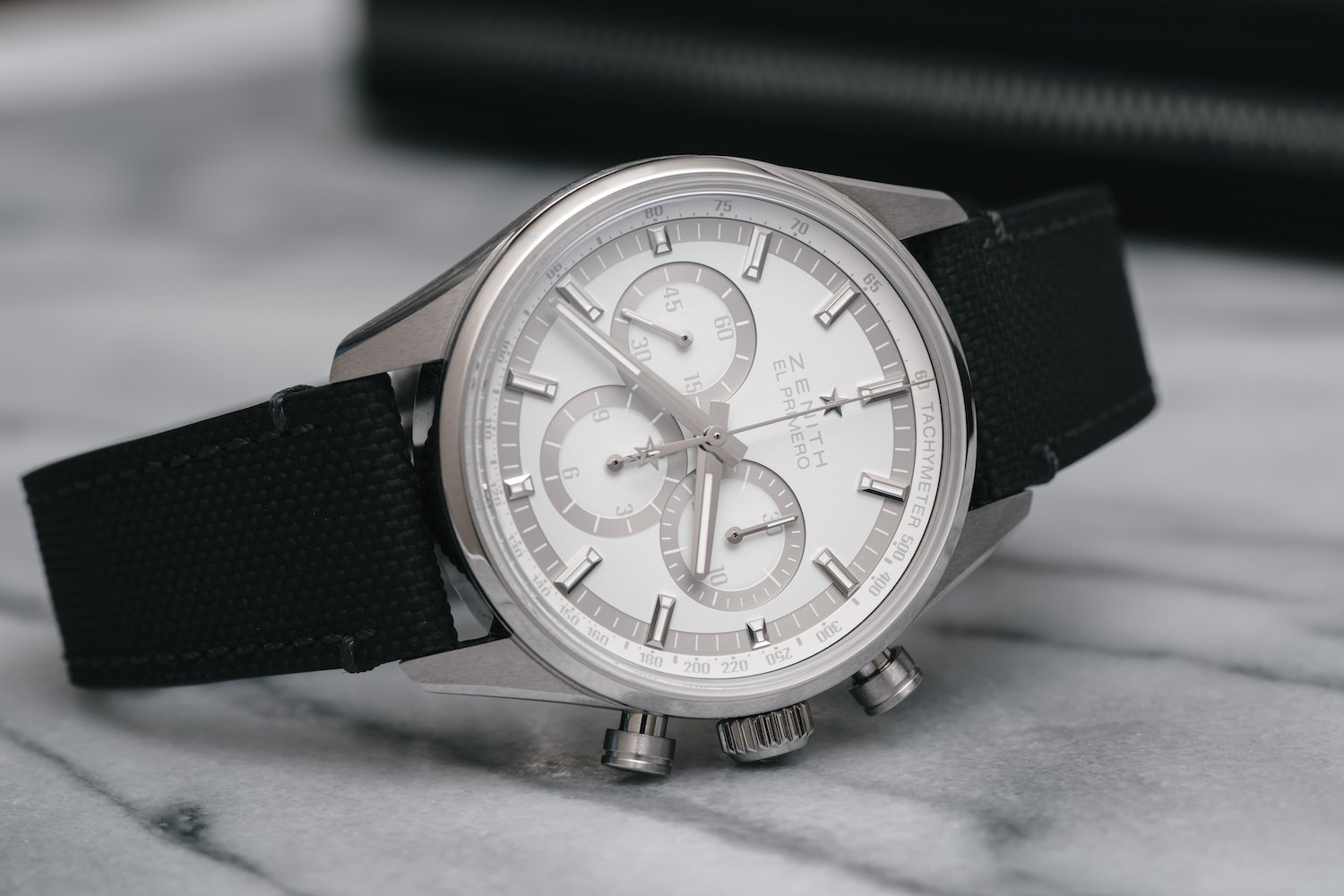
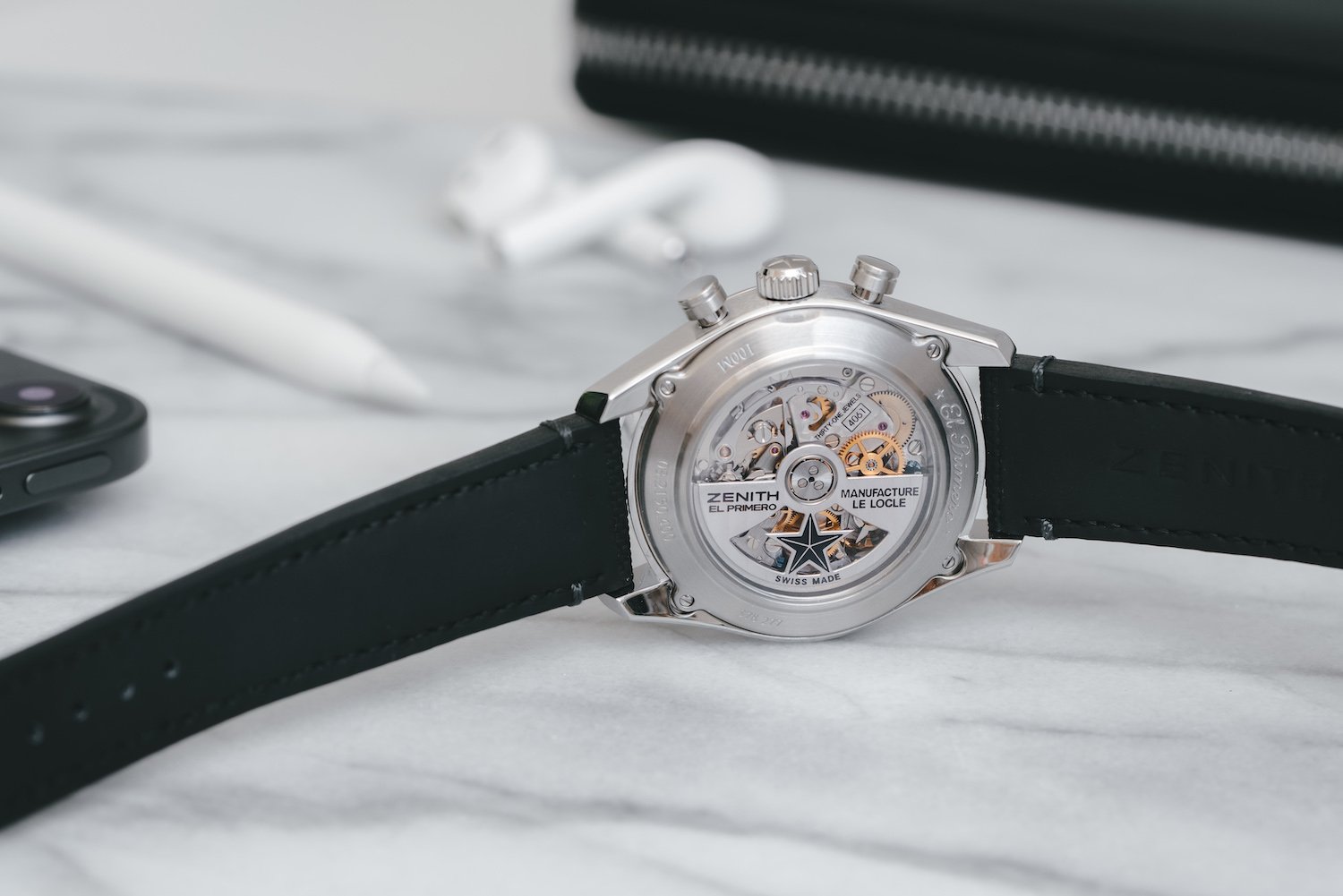
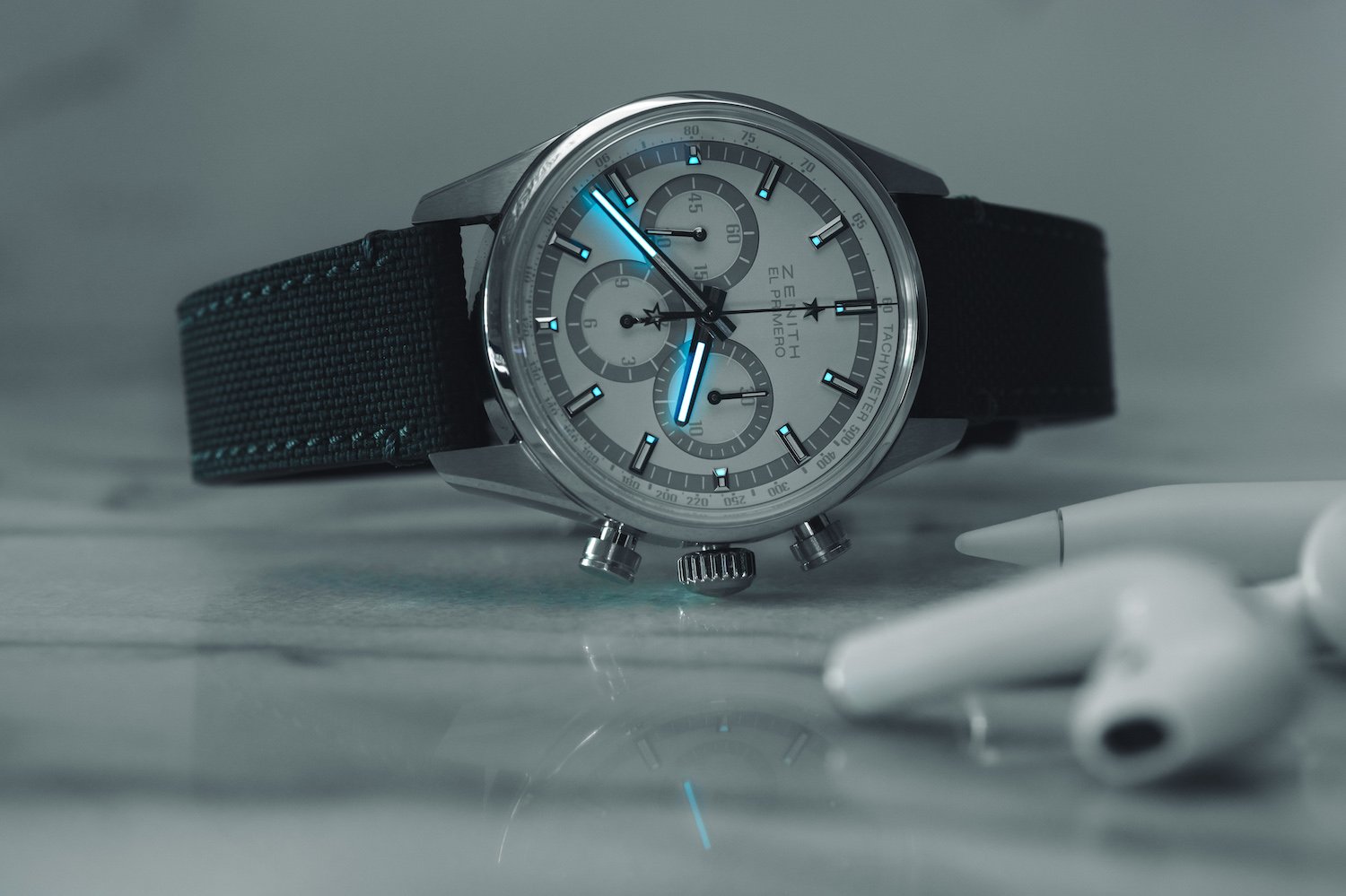

Watch enthusiast, collector or investor?
s the New York Times recently noted in an article about the exploding value of certain collectibles, from Air Jordans to Porsche 911s, “rich people who shopped too much used to be called collectors; now they are all investors.”
This expression obviously also applies to the watch industry, where we are seeing increasing use of the concept of “investment value”, as the prices of certain horological grail watches spike.
But what exactly are we talking about? Is the collectors’ watch market really as dynamic as we think it is? This is the question that consultant Thierry Huron (The Mercury Project) has sought to answer, by mapping watch auctions in 2020.
We are seeing increasing use of the concept of “investment value”, as the prices of certain horological grail watches spike.
-

- Patek Philippe Ref. 5002P- 001 Sky Moon Tourbillon, an extremely rare platinum double-dialled wristwatch with 12 complications offered at Christie’s in 2021
In his study, the expert estimates that the main auction houses (Phillips, Christie’s, Sotheby’s, Antiquorum, Bonhams) sold collectible timepieces worth 316 million francs last year, including buyer’s premium. This figure is 19% lower than the previous year, due to the pandemic.

Average auction price: 33,600 francs
These sales covered 9,400 collectors’ watches, representing an average lot price of 33,600 francs. Their total value may still seem modest compared to contemporary sales figures of the Swiss watch industry (with exports of 17 billion francs in the crisis year of 2020 – a wholesale figure that is lower than the final sale price) or to the Boston Consulting Group’s estimate of 16 billion euros for the second-hand watch market as a whole.
However, it should be noted that only a few brands account for the bulk of these sales, according to Thierry Huron’s study. Of the 22 lots that exceeded one million francs in value last year, thirteen were Patek Philippe models, four were Rolexes and two were F.P. Journe, a table completed by a Heuer, a Breguet and a Philippe Dufour (see list below).
-

- Watches auctioned in 2020 with a value of over one million francs
- Source: HammerTrack 2020, The Mercury Project
The growing polarisation between brand value in both the vintage and contemporary markets is also the result of the frenzy over certain particularly sought-after models, whether they date from 1961 or 2021. “Auction results have become a very important temperature indicator of the Swiss watch market and have proved their worth year after year for some of the most established watch brands,” notes Thierry Huron in his HammerTrack 2020 study.

The effect of transparency
The symbolic value of certain collectors’ models actually far exceeds their sale or resale price. They mobilise huge online communities of enthusiasts, and debates are raging on new discussion platforms such as Clubhouse, a social network particularly popular with horophiles, where people argue over the colour of the next Nautilus or the dimensions of the Daytona.
The real value of contemporary brands is increasingly underpinned by their resale price on the secondary market.
The real value of contemporary brands is increasingly underpinned by their resale price on the secondary market. “Rolex solid as a rock” was a headline in Morgan Stanley’s latest watch study with LuxeConsult, as it estimates that the market share of the brand with the crown (including Tudor) now exceeds that of the entire Swatch Group.
-

- Estimated in excess of CHF 3.5 million, this rare Patek Philippe yellow gold reference 2523 with cloisonné enamel dial, representing the Eurasian landmass, is a highlight of 2021’s Phillips’ Geneva Watch Auction XIII.
The transparency effect of digital technology has come to the fore, brazenly highlighting differences in value that watch brands used to hide. Most current press releases still struggle to give more information on the pricing of new models – a detail generally omitted, even though it is the first question future customers have.

Two extremes
This new context comes as quite a shock for an industry that, historically, has been anything but transparent. It is thus easier to understand both the discomfort of brands faced with the emergence of the secondary market, including collectibles, and price transparency (what brand would be happy to see its previous lots flagged with a big red “discount” tag on a second-hand site?), but also the rush to bring what is still largely a unregulated digital jungle, where authentic vintage collectibles rub shoulders with unsold or depreciated items, under more control.
Some brands face an overheating market that is diverting all the attention towards some of their most popular models. Patek Philippe, for example, has decided to discontinue its most popular Nautilus series and replace it with a new line (read here), while others are struggling with a climate where their models lose value once sold and resold, damaging the value of their more contemporary output.
-

- Rolex ref 1804 in Platinum with Hindi numerals. Watches with regional relevance are also prized. This timepiece was part of an online watch auction organized from Dubai by Christie’s in the spring of 2021.
We are seeing an acceleration of events in the secondary market. Consolidation is under way: Richemont has bought Watchfinder, Bucherer has bought Tourneau, Hodinkee has bought Crowne & Caliber, Watches of Switzerland has bought Analog Shift, and Chrono24 has recently hired an IPO specialist as its new CFO... This reflects both the dynamism of some highly sought-after collectors’ models and, more generally, the long lifespan of any mechanical watch model, even one of low “investment value”. The situation can always reverse: asymmetrical models that were not very popular in the past are now experiencing a strong revival of interest.

Yesterday’s and tomorrow’s brand value
“There is a real community of enthusiasts in the secondary market, but at the end of the day we are not the ones who decide what happens there,” Raynald Aeschlimann, CEO of Omega, told us. “We cannot target this market with the precision of a fighter pilot, as we would be able to do in our own retail network. All we can do is carry out the day-to-day work of enhancing and streamlining our contemporary collections and highlighting our heritage to help sales in general.”
“We cannot targets the secondary market with the precision of a fighter pilot, as we would be able to do in our own retail network.”
The iconic brand, which has not ventured into the pre-owned business, as other watch houses have, also has its waiting lists, including the 15,000 people (!) who have registered to receive the Speedmaster Silver Snoopy Award anniversary model.
-

- Launched last year by Omega, the Speedmaster “Silver Snoopy Award” 50th Anniversary is only available through long waiting lists.
“The objective, of course, was not to create a waiting list,” continues Raynald Aeschlimann. “I actually prefer to see the rating of some of our models increase gradually rather than experience sudden ups and downs. Above all, we have to maintain the desirability of our brand for the next generation. For example, we were among the first to launch NATO bracelets: younger people like to buy them for their vintage Omegas and one day they will buy them for the new version!”

The watchmaking community goes global
The question remains: what, today, is the main fuel driving the popularity of collectors’ watches? Is it the “sincere” motives of purists, the search for investment value, or just pure speculation?
One of our interviewees, a collector, has an interesting formula. She laments the arrival of people who are too interested in the purely speculative, almost mystical aura surrounding certain models. However, she also admits that the ability to retain value over time is one of her own purchasing criteria. It’s just not her main driver. That is exactly where the line between collection and investment lies.
A huge digital market has expanded the playing field for collectors, investors and speculators alike. All have access to more information and more contacts.
-

- Watch start-up Furlan Marri recently raised over a million francs on Kickstarter by reviving designs from the 1940s and 1950s at a very affordable price. An initiative that paradoxically speaks volumes about the state of the collection market.
Thanks to the greater transparency brought about the inter-et, whether in terms of pricing, origin or technical details (not to overlook the corresponding negative influence of fake news!), collectors have access to a much wider range of information than in the past. This allows them to make better-informed choices, including around whether their watch is likely to go up or down in value.
A huge digital market has expanded the playing field for collectors, investors and speculators alike. All have access to more information and more contacts, and therefore more potential opportunities with fellow collectors. Watch brands were already largely globalised. Now, the watchmaking community itself is going global.

The rise of the end customer
The buyers’ community is becoming more vocal, giving brands (which are also experiencing “digital bashing”) sleepless nights, along with a desire to win over new customers and grow.
The era of speculation that we are experiencing reveals above all the rising power of the end customer, who is finally claiming his place at the “horological table”, where brands and retailers had hitherto reserved most of the dialogue for themselves.
-

- On November 8, 2020, Phillips offered for sale the first model of a new edition of twenty Simplicity watches to be made by the great master watchmaker of the Vallée de Joux, Philippe Dufour. The watch sold for $1.5 million.
Now we are even seeing alliances between iconic collectors and iconic watchmakers, as is the case with the recent collaboration between Claude Sfeir and Philippe Dufour. Horological exchanges between private individuals are multiplying, with a rising number of collectors even founding their own “brands”.
Watch brands were already largely globalised. Now, the watchmaking community itself is going global.
They have all entered the dance, forming a highly eclectic group: wealthy collectors of long standing, penniless beginners, punters on rising values, simple enthusiasts. It is no longer a problem to collect both Casio and F.P. Journe, quite the contrary. The creation of a truly global community of enthusiasts is under way, thanks to the new digital tools we all have access to. The flaws that come with it, such as the casino effect surrounding certain timepieces, should not detract from the genuine dynamism of this new and fundamentally passionate scene.

A new watchmaking constituency
With the help of social networks, this new constituency is expressing itself ever more loudly, particularly when iconic brands launch new collections. Audemars Piguet saw this effect play out in 2019 when they launched the Code 11.59 collection, which was heavily criticised online, with notable sarcasm and irony regarding the aesthetics of its dial. The brand stood its ground, and is releasing new variations of the collection this year.
Paradoxically, a community of brand enthusiasts can be more conservative and purist – even fundamentalist! – than the brand itself. Any new initiative will now be scrutinised by the networks. Just as in the great game of democracy, politics is a cruel exercise and the ancien régime was certainly a more comfortable environment for brands that still wielded absolute power.
-

- Criticised on social networks when it was launched in 2019, Audemars Piguet’s Code 11.59 has stood its ground and is available in new models this year.
A community of brand enthusiasts can be more conservative than the brand itself. Any new initiative will now be scrutinised by the networks.
Certain communities of enthusiasts have contributed greatly to the popularity of the brands they follow. One of the most emblematic and long-standing cases, which dates back to well before the advent of social networks, is that of the Paneristi, the Panerai aficionados: a community of over 30,000 members brought together via more than 30 hubs around the world, with whom the brand maintains a permanent dialogue and produces limited series such as last year’s Radiomir Venti. They are, in a way, the “guardians of the temple”.
-

- Jean-Marc Pontroué, CEO of Panerai, maintains a close dialogue with the 30,000-strong Paneristi community of Panerai enthusiasts around the world. A special edition, the Radiomir Venti 45 mm, was created last year to celebrate the 20th anniversary of this community.
Panerai CEO Jean-Marc Pontroué continues to be amazed by the “ever-renewed passion” of the Paneristi. “They have a very accurate view of the brand, that of purists with a strong historical knowledge,” he told us. “With them, Panerai has an important, genuine and spontaneous visibility on the horological circuit, because they express themselves completely freely. We are an emotional brand. I prefer to manage a brand that is followed by enthusiasts who scrutinise all its develop- ments, even if it means being critical on certain points, rather than not provoking any reaction. With the strength of the networks, the community is even stronger.”

“Collectors are no longer ashamed to sell”
This eclectic community of enthusiasts is actually not content with simply commenting, but is becoming more and more a direct trading player in the watchmaking economy, by buying and selling their holdings at an increasingly rapid rate – whether we’re talking about 100-franc models or complicated timepieces worth hundreds of thousands of francs.
Having arrived seven years ago as head of Christie’s watch department in Dubai, after several years with Vacheron Constantin, Remy Julia has had a front row seat from which to observe this sea change in mentality. “In the Middle East, the local culture was one of buying, not reselling, which was associated with a notion of financial ‘need’”, he explains. “Historically, there have been major collectors here, but the majority of watches sold were sourced from other parts of the world.”
This has all changed in recent years, Julia stresses: “Now, half of our sales are made up of models from local customers, who have come to terms with the idea of selling watches at auction. They are no longer afraid of the neighbour’s gaze, so to speak.”
-

- Remy Julia, Head of Watches Middle East/India/Africa/Russia at Christie’s, organized a digital auction this year.
Here too, media coverage of iconic sales and models, the deepening of watchmaking culture with events such as Dubai Watch Week, and social networks have legitimised the idea of watches as investments, which can be bought and resold in a logic of financial diversification, among other things, on a much more fluid and fast-moving market.
“Our customers have come to terms with the idea of selling watches at auction. They are no longer afraid of the neighbour’s gaze, so to speak.”
More fundamentally, the process of buying and reselling watches has become far more natural, and is increasingly facilitated by online communication and the emergence of e-commerce platforms such as WatchBox, which has joined forces with the region’s leading retailer, Ahmed Seddiqi & Sons. Due to Covid, Christie’s also launched an online watch auction between late March and early April 2021. “The vintage watch market is now more important than the classic car market,” says Remy Julia. “There is a real demographic of enthusiasts, a quantity of transactions that has become phenomenal.”
Collectors have always been instrumental to the good health of the watch market. The mere act of collecting is probably almost as old as the first clepsydra. But enthusiasts have a more powerful megaphone than ever: from now on, they are largely in charge of an industry that has been forced to open up and listen to the sweet music coming at an ever greater volume from the community.
